

Successful Student Team Projects
Download Print Version of this Tip
Team assignments are a mainstay in the teaching of many disciplines and can deliver powerful benefits for students. These benefits including increased motivation and effort, deeper understanding of content and sustained academic performance, development of communication and teamwork skills, positive classroom relationships, and even improved psychological health and well being (Johnson, et al., 2014; Joshi, et al., 2022; Poort, e al., 2020; Swanson, et al, 2019).
If team assignments are not designed well, however, they can be difficult experiences for both students and faculty. Commonly reported problems include unfair distribution of work, relationship conflicts, poor planning, communication problems, and lack of engagement (Iacob & Faily 2019; Opatrny-Yazell & Houseworth, 2018).
The good news is that evidence-based practices exist for preventing and responding to these issues and these practices can make your team assignments highly successful. This handout organizes some of those practices around things to do in class (1) before project work begins and (2) while it is underway, as well as (3) how to structure the project itself so it unfolds productively over time.
1. Before Project Work Begins
Two important ideas for planning successful team projects are (1) the mental models we use to understand the world, and (2) the distinction between team work vs. task work.
W e all create mental models of how the world works and teams perform better when members get practice aligning their understandings of each other and their work (Stout, Cannon-Bowers, Salas, & Milanovich, 2009). It is this experience that shifts students from thinking of themselves as individuals to thinking like a team member. You want to give teams as many opportunities as possible to practice bringing their understandings of many things into convergence–both during project work and also other in-class work like team-consensus discussion activities and even quizzes. This repeated practice converging their mental models makes them better able to think as a team.
We not only create mental models of concepts and tasks–we also create them about each other and our relationships, which leads to the distinction between task work and team work (e.g., Guchait, Lei, & Tews, 2016 ). Task work consists of the functional, content-focused activities of the team and team work describes the set of perspectives and actions required to productively work with other people toward a common goal. Successful team projects require both task work and team work to be done well, and a well-organized assignment can help your students learn how to do both.
Organizing Successful Teams
Size: Teams should be no larger than necessary to succeed at the work of a team project. Motivation decreases and complications increase with larger teams (Gibbs, 2009). As team size increases, so does the complexity of aligning mental models and the possibility that team work needs could overshadow task work. Teams of four or five students are commonly considered “right-sized” (Hunkeler & Sharp, 1997; Monson, 2017; Swanson, et al. 2019).
Composition: Avoid allowing students to choose their own teams. Students tend to choose those similar to themselves, which can lead to homogenous and underperforming teams, and pre-existing relationships can create cliques within teams (Sibley & Ostafichuk, 2014). Instead, strategically populate your teams by determining what characteristics would make it easier or more difficult for students to do the expected work, and distribute those characteristics as evenly as possible across teams (Sweet & Michaelsen, 2012). It is also important to ensure that students with marginalized identities are not the only one with that identity on their team (Macke, Canfield, Tapp & Hunn, 2019).
Duration: Early stages of team relationships are marked by social anxiety as members learn about each other and find their place in the team (e.g., Levi & Askay, 2020; Poole, 1983; Tuckman & Jensen, 1977). These concerns diminish and productivity increases as shared experiences accumulate. Across time, relationships deepen and students move toward converging mental models of both the task at hand and the team itself (McComb, 2007). Therefore, project teams should be as permanent as you can make them.
Rotating Project Manager Role: Producing complex products in teams is so difficult that an entire workplace profession has arisen to support it: the profession of project management–which has a great deal to offer student project assignments (Hussein, 2021). A rotating project manager role in each team can provide the coordination and information that teams need to make progress toward the next deliverable. In addition to providing essential support for both task work and team work, a student’s time as project manager can be a rich experiential learning activity for them.
Launching Successful Teams
Orienting Students to Successful Teamwork: Giving students an orientation to successful team work can foster mental model convergence and team work skill development. What does good team work look like in your discipline? Drawing from your own experience as a team member, you can highlight the importance of things like attendance, responsibility, and commitment, along with suggesting processes for decision-making, conflict management, and meeting management, for example (Tombaugh & Mayfield, 2014). Drawing also on students’ own past team project experiences, concerns, anticipated challenges, and recommended strategies can make for a very relatable conversation for all (O’Connor & Yballe, 2007).
Practice Activity: Small scale practice or “launcher” activities provide students with a low stakes opportunity to collaborate before the project begins and begin the process of mental-model convergence without the pressure of grades or the complexity of the project (Holbrook & Kolodner, 2000). Engaging students in such activities can help teams get to know each other, establish norms, and try out their decision-making and collaboration skills. Practice activities are most effective when they conclude with prompts for students to reflect on their own contributions and those of others, what worked well, and what didn’t.
Templates for Organizing: Providing project documentation can scaffold students’ planning process, support mental model convergence, and serve as helpful tools for keeping the project on track (Hunsaker, Pavett, & Hunsaker, 2011). A Team Charter template, for example, provides space for students to document their ground rules and team processes (Hunsaker, Pavett, & Hunsaker, 2011). Team Charters are important: they are a place where the team can move toward mental model convergence around what they think good team work looks like for them. A Project Plan template can help students break the work down into smaller tasks, assign those tasks to individuals, and identify deadlines–helping to align mental models around task work.
2. While Team Project Work is Underway
Two-Stage Quizzes can be powerful for learning course content and team building (Sibley & Ostafichuk, 2014; Zipp, 2007). These activities begin with students first taking a quiz or test over course content and turning it in. They then take the exact same quiz as a team, coming to consensus on their team answers and getting immediate feedback on their team performance. This second stage of discussion and immediate feedback is often extremely motivating and rewarding as students clarify their understandings and explain things to each other in their own words. This practice of mental model convergence builds cohesion within a team that can support teammate relationships across their other project work.
Team Work Peer Assessments not only ensure individual accountability but also provide students with critical information about what their teammates value from their contributions and how they might grow their teamwork skills. These assessments should occur at least once during the project work–not just at the end of the term–and often include prompts about what teammates “Appreciate” about and “Request” from each other (Sweet & Michaelsen, 2012). Free software platforms like TEAMMATES can make the process very efficient ( teammatesv4.appspot.com ).
3. Structuring the Project Assignment
Project Size and Complexity: One factor in team dynamics is the size and complexity of the project (Aggarwal & O’Brien, 2008). The scope and complexity of the project should be appropriate for the number of students on the team as well as their developmental level and project experience. Projects that are too easy or narrow could result in social loafing, while projects that are too difficult or broad can be overwhelming and frustrating.
Iterative Assignments and Feedback: Too often, students do not receive feedback or guidance until they have completed an assignment. Assignments like drafts or other forms of iteration—and feedback given between versions—enable students to learn from their mistakes and apply what they have learned to get back on track. This approach is associated with gains in student performance in multiple disciplines (Hattie, 2009). For maximum impact, feedback should serve as an interim step that guides students toward successfully completing and achieving the goals of the assignment (Ambrose, et. al., 2010). Feedback from multiple sources, including peers, instructors, and any external stakeholders is most valuable.
Both Individual and Team Grades: What you choose to grade sets students’ expectations, signals to them what is important, and thereby drives behaviors. While solely individual grades for team work may lead to accountability and perceptions of fairness, they may fail to promote collaboration (Opatrny-Yazell & Houseworth, 2018). Alternatively, team grades alone may provide cover for social loafers and lay the groundwork for conflict. Therefore, the ideal is to assess performance at both the team and individual levels. In addition to instructor-assigned grades, periodic self- and peer assessments should be included to focus attention on team processes as well as one’s own learning and contributions.
How These Practices Can Come Together
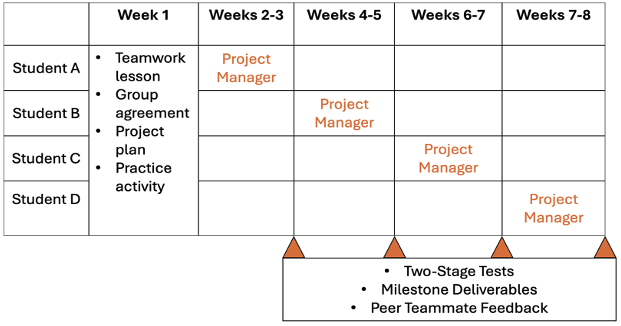
Aggarwal, P., & O’Brien, C. L. (2008). Social loafing on group projects: Structural antecedents and effect on student satisfaction. Journal of Marketing Education, 30 (3), 255-264.
Ambrose, S. A., Bridges, M. W., DiPietro, M., Lovett, M. C., & Norman, M. K. (2010). How Learning Works: Seven Research-Based
Principles for Smart Teaching . John Wiley & Sons.Gibbs, G. (2009). The assessment of group work: Lessons from the literature [white paper]. Assessment Standards Knowledge Exchange.
Guchait, P., Lei, P., & Tews, M. J. (2016). Making teamwork work: Team knowledge for team effectiveness . TheJournal of Psychology, 150 (3), 300-317.
Hattie, J. (2009). Visible learning: A synthesis of over 800 meta-analyses relating to achievement . Routledge.
Holbrook, J., & Kolodner, J. L. (2000). Scaffolding the development of an inquiry-based (science) classroom . In B. Fishman & S. O’Connor-Divelbiss (Eds.), Fourth International Conference of the Learning Sciences (pp. 221-227)
Hunkeler, D., & Sharp, J. E. (1997). Assigning functional groups: The influence of group size, academic record, practical experience, and learning style . Journal of Engineering Education , 86 (4), 321-332.
Hunsaker, P., Pavett, C., & Hunsaker, J. (2011). Increasing student-learning team effectiveness with team charters . Journal of Education for Business, 86 (3), 127-139.
Hussein, B. (2021). Addressing collaboration challenges in project-based learning: The student’s perspective . Education Sciences, 11 (8), 434-454.
Iacob, C., & Faily, S. (2019). Exploring the gap between student expectations and the reality of teamwork in undergraduate software engineering group projects . Journal of Systems and Software, 157 , 110393.
Levi, D., & Askay, D. A. (2020). Group Dynamics for Teams . SAGEPublications.
Johnson, D. W., Johnson, R. T., & Smith, K. A. (2014). Cooperative learning: Improving university instruction by basing practice on validated theory . Journal on Excellence in College Teaching , 25 (3–4), 85–118.
Joshi, T., Budhathoki, P., Adhikari, A., Poudel, A., Raut, S., & Shrestha, D. B. (2022). Team-based learning among health care professionals: a systematic review . Cureus , 14 (1).
Macke, C., Canfield, J., Tapp, K., & Hunn, V. (2019). Outcomes for Black students in team-based learning courses . Journal of Black Studies, 50 (1), 66-86.
McComb, S. A. (2007). Mental model convergence: The shift from being an individual to being a team member . In Multi-level Issues in Organizations and Time (Vol. 6, pp. 95-147) . Emerald Group Publishing Limited.
Monson, R. (2017). Groups that work: Student achievement in group research projects and effects on individual learning . Teaching Sociology , 45 (3), 240-251. https://doi.org/10.1177/0092055X17697772
Opatrny-Yazell, C. M., & Houseworth, M. A. (2018). Understanding student perceptions of teamwork . Journal on Excellence in College Teaching, 29 (2), 43-71.
Poole, M. S. (1983). Decision development in small groups, III: A multiple sequence model of group decision development . Communications Monographs, 50 (4), 321-341.
Sibley, J., & Ostafichuk, P. (2023). Getting started with team-based learning . Taylor & Francis.
Sokman, Y., Othman, A. K., Aziz, A. A., Musa, M. H., Azizan, N., & Rahmat, N. H. (2023). Stages in team work: Is there a relationship among them? International Journal of Academic Research in Business and Social Sciences, 13 (11).
Sweet, M., & Michaelsen, L. K. (2012). Critical thinking and engagement: Creating cognitive apprenticeships with team-based learning . In Team-Based Learning in the Social Sciences and Humanities (pp. 5-32) . Routledge.
Tombaugh, J. R., & Mayfield, C. O. (2014). Teams on teams: Using advice from peers to create a more effective student team experience. Academy of Educational Leadership Journal, 18 (4), 69.
O’Connor, D., & Yballe, L. (2007). Team leadership: Critical steps to great projects. Journal of Management Education, 31 (2), 292-312.
Poort, I., Jansen, E., & Hofman, A. (2022). Does the group matter? Effects of trust, cultural diversity, and group formation on engagement in group work in higher education . Higher Education Research & Development , 41 (2), 511–526. https://doi.org/10.1080/07294360.2020.1839024
Swanson, E., McCulley, L. V., Osman, D. J., Scammacca Lewis, N., & Solis, M. (2019). The effect of team-based learning on content knowledge: A meta-analysis . Active Learning in Higher Education , 20 (1), 39-50. https://doi.org/10.1177/1469787417731201
Tuckman, B. W., & Jensen, M. A. C. (1977). Stages of small-group development revisited . Group & Organization Studies, 2 (4), 419-427.
Zipp, J. F. (2007). Learning by exams: The impact of two-stage cooperative tests . Teaching Sociology, 35 (1), 62-76.
Difference Between Assignment and Project
It’s important to know the difference between these two terms. According to Answers.com , assignments are focused on specific, and predefined tasks whereas projects involve a variety of interrelated tasks which are performed to achieve a particular aim.
Main Differences Between Assignment and Project
Assignments are textbook focused while project encourages hands-on learning.
The project, on the other hand, is dependent on the performance of others, your team, and a collective effort. As such, it is not a good judge of a student’s capabilities. Unlike a project, an assignment is also a significant pointer to a student’s weakness and a guide in correcting it.
Consider a given assignment on World War I. Everything done on the questionnaire would be aimed at answering the questions asked. The teacher might even permit the students to consult several textbooks to help them properly frame their responses. Everything is being tailored in line with the curriculum, including the research done on the assignment.
Assignments are usually given on an individual basis. It helps a student be self-reliant and confident in his ability to accomplish a task. This method helps to personally improve assignment writing skills of students while projects encourage students to interact and work together to come up with a solution. This gives rise to teamwork and the ability to delegate, which are vital for life.
How to Give Assignments to Team Members
Table of Contents
The project has been divided into milestones, goals and objectives broken into tasks, and now it’s time to assign them. But as you open the project management platform, you’re faced with the unflattering process of wording the tasks, and choosing whom to assign them to.
Well, in this article, we offer advice on how to make that jumbled first moment a little clearer. There are actionable tips, learning the difference between allocating and delegating tasks, and suggested criteria on how to choose the best person for the job.
For a more precise overview, here’s a table of contents:
How do you assign employees tasks?
We normally think that assigning tasks is a time-consuming process that focuses on clearing out task lists to keep the project going. However, task assignment should actually be a more employee-oriented process that requires additional dedication and effort, which yields incredible results. But what do we mean by that?
Properly assigned tasks push your employees, projects, and the overall company forward. Here’s how.
- They strengthen accountability and trust between managers and employees;
- They help teach new skills and perfect old ones;
- They allow employees to get familiar with other teams and avenues of work;
- It becomes easier to make project estimates;
- Makes for great bases for performance reviews, etc.
The list could go on, but we’ll stop there for now.
Of course, such long-term benefits don’t come without some proverbial blood and sweat in the planning stage. Let’s take a look at the general ideas on assigning employee tasks, and specific steps you can take.
Motivation comes from knowing the bigger picture
When we talk about the bigger picture in project management, we talk about each team member’s task affecting their peer’s down the line. Since all tasks are usually small pieces of the puzzle, it helps to remind employees how their work contributes. For example:
- A high-quality draft can make a great foundation for the final version, and it can be completed more quickly.
- A well-prepared presentation can shave time off unnecessary questions and additional email inquiries.
It comes as no surprise that people work better and are more productive, when they know that their work has an impact on the company level.
And so, when you assign tasks, try to emphasize how they fit in the bigger picture. Simply saying: “ You doing X will help with Y and Z ” and how it reflects on the project as a whole will let an employee know that the task they were assigned is important.
Get your employees excited to commit
Telling people about the bigger picture and showing them what’s possible can only get them so far. It’s enough to ignite the initial spark, but for them to fully commit to the task, you need to define what that task entails.
They should be able to picture how to go about the work, what skills to use, and how to reach the desired result. The clearer the instructions, the more motivated they will be to work.
Simply put, give directions on how the task should be done, and make sure they understand. You can’t read each other’s minds, so it’s important everyone is on the same page.
Ask for task transparency
One of the best practices a company can employ is transparency among coworkers.
This is achieved by having everyone input their tasks for the day in a timesheet. The purpose of timesheets is to get an accurate idea of what everyone is working on at any given time.
When people know who works on what tasks, it’s easier for them to know if a person is available or busy, how far along they are with a task, etc.
So, when you give assignments to employees, label them with deadlines. Alternatively, you can ask for employees’ assessments on how long the work would take them, and use those timeframes.

Source: Clockify team timesheet
Timesheets are a great way to keep an eye on tasks and the people doing them. You get to:
- see who struggles with what (helps assess people’s skill sets);
- who burns through their workload and is available for additional tasks;
- whether your time estimates need correction;
- identify any wasted time.
💡 If your employees are insecure about keeping public records of their tasks, here are a few resources that can help:
- How to create order in your daily work tasks
- How to be more efficient with your tasks
Keep a crystal clear timeframe
While we’re discussing timesheets and deadline transparency, it’s important to mention that the times you set for task completions need to be clear-cut.
As we’ve mentioned, the safest way to assign deadlines is to consult the employees. They are better at assessing how long it will take them due to the tasks’ difficulty, overall deadlines, the standards that need to be met, and the skill required to complete it.
When they get a say in how long they should be doing an assignment, people tend to feel more accountable for the whole process. They will do their best to finish in time, since they actively participated in setting the deadline.
Set very clear expectations
Assigning a task should always include your (the supervisor’s) expectations pointed out. For example:
- Does a logo pitch need as many drafts as possible, or just a few finished pieces?
If you ask a designer to make some drafts for a logo pitch, you must specify the kind of quality you’re looking for. Explain whether you are looking for some sketches and drafts for a brainstorming meeting, or if you want clean, presentable pieces to show.
Additionally:
- How many pieces should the designer do?
- Is there a specific color palette they need to follow?
- How important is the task? Is this the day they finally decide on a logo, or is it still in the brainstorming stage? (decides on the quality of the work itself)
Assigning the task using the above questions, you help the designer understand how much effort precisely they need to invest. They become more motivated with clear instructions, as they know what is expected of them. There’s no fear of having their work criticized for something that wasn’t communicated in the beginning. And on your end, it prevents breached deadlines or subpar results.
Avoid creating dependency by being less involved
It’s not unusual for employees to ask their supervisors for their opinion on a certain task, or their performance.
The problem arises when a supervisor makes themselves too involved with the process. When they feel like the project might fall apart if they don’t have their eyes on every moving part all of the time. And when you have, say, 20 people waiting for that person’s approval, advice, or consultation, the workflow runs into a gridlock.
And wait time is wasted time.
Plus, people lose motivation, patience, and grow frustrated, as they could be doing other things.
So, learn not to jump in every time people call for your aid. Assign reliable people who can address smaller issues, while you handle the big picture. Learn how to expend your own energy where it is needed more.
For example – making a pitch presentation for potential investors keeps getting put off because one person needs you to check a client email they want to send, another wants your signature on a form, and the third wants to ask something about employee feedback that’s coming up.
In order to not be stretched thin, and have your time wasted on menial tasks, here’s where you can start:
How to mitigate the risk of being over-involved when assigning
- Remember that you match tasks to people
Which means that, by matching the right people with the right tasks, your involvement will be minimal. Take time to carefully choose who gets to do what. What is the point of assigning tasks if they can’t be done without you?
- Have a 10-point scale to judge the importance of items
How important are certain aspects of your leadership role? Are you absolutely necessary in every meeting, or during every call? Which tasks need your approval, and which ones can be approved by someone under you?
Rank these items on a scale of 0 to 10, based on their importance to you and the project. Top priority tasks should get your undivided attention. And what can be delegated, should be.
- Analyze your schedule
Your energy and time are needed on a much broader scale. The best way to spot if you’re wasting time being too involved is to look at your schedule. Identify how much time you’ve spent on low-priority items, and assess which issues could’ve been solved without you.
- Take into account priorities and deadlines
Step in only when absolutely necessary. You are in charge of things getting done on time, by people most qualified for assigned tasks. Determine what your priorities are for each project, and concern yourself only with those issues, unless there is a risk of breaching a deadline.
- Formulate a list of dependable people
If you know your employees (or team members) well enough, then you should be able to single out those who are more dependable and ready to take on a little more responsibilities. Write out the reasons how they could help by getting involved on low-priority items instead of you. When the time comes, rally them and present them with the idea, keeping in mind that this solution helps push the project forward. When authority is delegated to several people, there’s fewer chances of a hold-up in the workflow.
This also falls into the realm of task delegation , which we’ll get into later.
How do you decide what tasks to assign to which employees?
1. assign based on priority.
Naturally, some tasks will be more important than others. When you break down a project into tasks , spend some time assessing their priority level.
High-priority tasks should be the first on your list to allocate. Whether it’s because they’re time-sensitive, or require more effort and dedication.
Low priority tasks can be allocated as fillers to the first available person.
2. Assign based on employee availability
Another factor to consider when assigning tasks is who is available at the moment.
As the project moves along, new tasks will be added. You will have to allocate new work, but odds are you won’t always be able to pick who you want. Especially if a deadline is approaching, the person with the smallest workload should be your first choice.
Overloading an already busy individual just because they’re more skilled or you have faith in them the most puts an unnecessary strain on them. It’s cause for frustration, poorer results, and decreased productivity.
And as we’ve mentioned, if you have a timesheet with an overview of all the tasks and employees working on them, it’ll be much easier to spot who is free and who isn’t.
3. Assign based on employee skill level
High-priority tasks should go to employees with more experience in a given field or skill. However, you should occasionally give such tasks to other employees as well, to help them grow and become just as dependable. Giving people challenging tasks that can boost their experience is essential to productivity and morale.
Not to mention you get to have multiple high-skilled employees.
Low-priority tasks can be assigned to anyone, despite their experience level. They’re a good opportunity to practice, pick up new skills, or get smaller tasks out of the way to make room for more important ones.
4. Assign based on preference
Last, but not the least, preference can also play a big part in how you assign tasks.
It’s a given that some employees will prefer certain tasks over others. So it could be good to assign tasks at a meeting with the team. As you discuss priorities, deadlines, and availability, ask them which tasks they would like to work on.
If someone shows interest in a specific type of work, they should (with some consideration), be allowed to take it. After all, people are more productive when they’re assigned to something they find new or exciting.
Note: Apply this rule with caution. Letting people do only the tasks they want can stunt their career growth. Getting out of our comfort zones and occasionally doing tasks that we don’t like is how we develop and learn. So, don’t forget to document assignments as you hand them out, to spot these potential issues early on.
Allocating vs delegating tasks
While semantically similar words, delegation and allocation in terms of tasks are two different things.
When you allocate tasks , you are assigning tasks without giving the employees much authority, challenge, or room to grow. It includes you keeping all of the responsibility – writing out the tasks, making deadlines, providing resources, tools, etc. These are usually recurring tasks that can become repetitive.
When you delegate tasks , you allow for some of that responsibility to fizzle out from your fingers. All you think about are the objectives, while letting the employees figure out the details and means to get there.
However, that doesn’t mean delegation is right and the allocation is wrong.
Task allocation has its own place. It is just as important, as a lot of tasks come down to repeated processes that are still vital to the project progress. Task delegation is just a good opportunity for employees to learn, challenge themselves, and assess their skills and performance.
When should you allocate tasks?
Management and BizDev consultant Artem Albul shared his concept on task assignment, which he dubbed an “algorithm”. He emphasized how these criteria are useful only and only when you wish that employees perform the tasks based on your guidelines and instructions (aka allocation).
Here is how Albul broke down the algorithm:
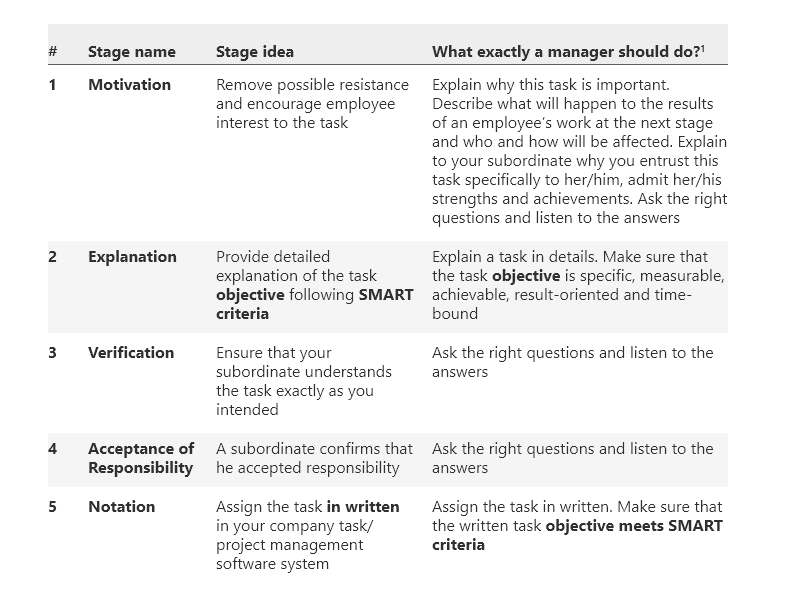
Source: Artem Albul, TWA Consulting
As we can see, task allocation, while the more “controlling” of the two, also gives in-depth instructions and asks for confirmation on task clarity. A lot of it comes down to everyone being on the same page, leaving little to no room for misinterpretation (but also creative freedom).
How should you allocate tasks?
With all that we’ve mentioned in the previous section, here’s how your task allotment could look like, step by step.
- Break down your project
Detail out the goals, objectives, and some individual tasks (not all, be careful not to start micromanaging). Place the most important deadlines.
- Prioritize tasks and sort them
It’s important to know what tasks need to be done faster/better, to properly allocate your resources and manpower from the start.
- Make a list of teams and team members
Assign team leaders (if you don’t have them), and alternatively, ask for their input on individual employees skills, for a more informed decision on who gets what.
- Schedule a meeting
Make a meeting with the team leads and go through the points above. Assign tasks according to each team’s availability, interest, and skill required to successfully push the project forward.
- As team leads – assign tasks further down the pipeline
- Track task completion and make necessary changes along the way
Whether it’s pushing deadlines, reassigning tasks, or shifting around resources. This is perfectly fine and expected, so long as it doesn’t happen on every task you’ve assigned. Then, it is an indicator of poor pre-planning.
- Offer feedback and write performances
Don’t forget to track the progress and make notes of important details that might help the next task allocation/delegation process. It’s also a useful piece of information for the employees on what they need to improve on.
Allocating tasks is somewhat more complicated than we want it to be. But, this kind of thorough research and preparation will make projects run more smoothly. Employees will also be more satisfied with their work, and there will be less hurdles as deadlines approach.
When should you delegate tasks?
Delegation is a great practice in trust for both the employer/supervisor and the employee. The employer learns how to give away some of their control over the process, while the employee learns how to take more accountability for their work.
This lets you focus on big-picture aspects of your job, since you deal less with assignments that are low-priority for you. You save time and energy, while helping others move up in their careers.
How do you effectively delegate tasks as a leader?
As we’ve mentioned, delegating includes more employee independence. There are some additional components which make this type of task assignment more appealing than allocation, with great opportunities for growth.
Focus on delegating objectives instead of actual tasks
When you delegate, you focus on the objective that needs to be done. You shouldn’t give employees a “color by numbers” instruction on how to complete a task.
Communicate clearly what the end result should be and what expectations you (or the higher-ups) have. Leave the means for reaching that end goal to the employees themselves. Because how you solve a task may be completely different to how they will. And that is perfectly fine, so long as the result is the one you are looking for.
Keep the objectives challenging
When the objectives you’re delegating are too easy, chances are the person will either procrastinate, or feel like you don’t trust them enough. And if they’re too difficult, they get frustrated, anxious, and begin to panic.
It’s a good idea to be aware of an employee’s skill level, so you can gauge how much challenge and responsibility they can take on. For them to be the most productive and achieve great results, they need to enter “the state of Flow”.

Source: Optimal Experience , M. Csikszentmihalyi
💡 We’ve discussed the state of Flow in more detail in an article on time organization.
Encourage discussion and feedback
Let employees voice their opinions on the topic.
They should ask anything about the task, the goals, or the overall impact their work will have on the later stages or others’ workflow. It means they are interested in the task, and getting involved.
And if they aren’t asking questions themselves, you can always nudge them into proactivity.
- Is there something you’d like me to clarify?
- Do you already have any ideas on how to go about the task?
- Is the time we agreed upon enough for you?
- Will you need other resources, tools, or support?
- Do you see any problems or risks?
Questions like these help them feel valued, their efforts acknowledged, and let them know you care about the task and how well they perform. Just be careful not to overdo it, or you’ll start to look like a micromanager.
Give employees free rein, but offer support
Speaking of micromanaging, delegation means you let people problem-solve their way out on their own. There should be no reason for a manager to step in and control or supervise any step of the process, unless absolutely necessary.
However, what you should do is let them know you’re available for any advice should they feel stuck. Just because employees get authority on a certain task, and are left to their own devices, doesn’t mean the project has to suffer until they pull themselves up.
From time to time, ask them if they need anything from you, and make sure they know you’re there for any kind of support, consultation, or mediation. ANother good practice is to also give them additional learning opportunities – such as training, conferences, courses, etc.
Delegate objectives that move people forward
Choose assignments that boost the skills and employ all of their experiences, instead of something that simply needs to be done. For example:
- Tasks that require they brush up on their team communication skills;
- Learning how to allocate smaller tasks;
- Supervising others’ work and doing quality control;
- Learning to work with a new tool;
- Holding a meeting (or more), etc.
Find out which skills your employees may want or need to develop, and then plan your delegations accordingly. You want them to complete the task while having learned something new at the same time.
How to choose who to delegate to
Paul Beesley, senior director and consultant at Beyond Theory proposed a nifty checklist for when you’re choosing an employee to delegate to. It’s meant to simplify and speed up the process.
To successfully complete the delegated task, your chosen employee needs:
S – the skill to perform and complete a task
T – the time to complete the task, and if needed, learn the required skill
A – the authority to handle everything concerning the task
R – the necessary level of responsibility
R – the recognition for successfully completing the task
This list is a set of important criteria that should be covered when you consider who to assign to a specific task. However, depending on your niche, type of service, company size and the project at hand, the criteria are likely to change. And it should accommodate your needs, not the other way around.
Common task delegation mistakes to avoid
With all being said, there are some common mistakes managers and employers make, sometimes without even realizing it.
- Being too vague concerning deadlines (using: as soon as possible, when you get to it, I need it by yesterday). It creates unnecessary pressure.
- Being unavailable for questions and concerns. While you shouldn’t micromanage, you should still be present for support if an employee feels stuck. Ignoring them or handing them over to someone else could cause distrust. However, if you are usually swamped with work, set consultation hours each day or week.
- Having unclear directions. Specifying the allotted time for task completion and expectations should be the bare minimum when delegating tasks.
- Not providing feedback. No feedback is worse than bad feedback. Employees need to be aware when they’re doing good work, as well. In one company I worked for, the mantra was: “If no one is complaining about your work, that means you’re doing good”. And while it sounds like sound logic, it actually caused a lot of frustration. We were left directionless, and simply “floating” from task to task, never knowing if any of them had a positive impact on our performance.
- Not listening to employees. Take into account how they feel about a task or the objective. Let them give you feedback and if there are potential problems from the get-go.
- Assigning other people to the same task. If you notice a person struggling, the first instinct should be to ask them how they’re faring, and if they need any help. Some managers tend to assign other employees to help them without consultation, which leaves a sore taste. The employee will feel even more incompetent and will be less likely to take on a similar task in the future.
- Assuming people will know what you mean. This is one of the biggest problems. When you’re formulating a task, be as clear as possible about the goals and expectations. Oftentimes managers think that these things are implied, but the truth is – no one is a mind reader. To avoid having information misconstrued or misunderstood, communicate clearly and directly.
There could be more mistakes, especially for every different field and industry. If at all possible, identify the most common ones, made either by you or your peers. Note down all the instances where certain tasks weren’t up to par, and see what you could have changed in your assignment process to fix it. Maybe there wasn’t enough time or resources, you were unclear, or the employee wasn’t ready for such responsibility. Use the same procedure in all future task delegations. It’s the only way to learn and make the process quicker.
Use Clockify to assign tasks with ease
Now you’re a master of task delegation — congrats!
But there’s more to it than meets the eye.
In fact, what if you used a digital tool like Clockify to increase the likelihood that each job would be completed on time and on point?
In Clockify, you can easily create highly descriptive assignments that contain information like:
- Start time,
- Billability status,
- Name of the employee,
- Period for getting the assignment done,
- Hours per day to spend on the assignment, and more.

That way, you can plan who works on what, how long, and when.
Similarly, Clockify allows you to create project milestones to achieve results faster.

With the Milestones option, you can select dates for deadlines, allowing you to pin down important events in your projects.
For example, if your client expects you to keep them in the loop about developments, you can inform them promptly on whether your team has reached the agreed-upon milestones.
Refocus on your company’s big picture with a project and time tracking tool.

Marijana Stojanovic is a writer and researcher who specializes in the topics of productivity and time management.
Where does the time go?
START TRACKING TIME
with Clockify
How Clockify Transformed Team Time Tracking Forever
Learn more about Clockify’s rising to the top and what sets it apart from other time trackers for teams.
How to create a PTO policy
Everything you need to know about creating a PTO policy — from the basics of PTO to choosing a PTO tracking system that suits your workflow.
Working Overtime Without Pay – Know Your Rights and Options
Discover the legal and financial aspects of working overtime without pay. Learn your rights and how to handle common concerns regarding off-clock work.
PTO vs. Vacation: What Is the Difference?
Learn the difference between PTO and vacation and find out the answers to the most frequently asked questions regarding paid leave!
Best methods for tracking team productivity
Find out the most useful methods of tracking team productivity, followed by actual examples of how different teams measure their effectiveness.
Difference between a freelancer, a contractor, and an employee
Learn which work category you fall into, to better protect your rights as a worker and avoid worker exploitation.
FREE FOREVER • UNLIMITED USERS
Free time tracker
Time tracking software used by millions. Clockify is a time tracker and timesheet app that lets you track work hours across projects.
How to Plan and Carry Out a Project or Assignment

Introduction: How to Plan and Carry Out a Project or Assignment

Step 1: Starting

Step 2: Negotiation.

Step 3: Time and Resources

Step 4: Outcome

Step 5: Judgement!

Step 6: For Teachers.

Participated in the The Mad Science Fair

Participated in the 4th Epilog Challenge
Recommendations

Farm to Table Contest

Outdoor Life Contest

Make it Resilient


Understanding Assignments
What this handout is about.
The first step in any successful college writing venture is reading the assignment. While this sounds like a simple task, it can be a tough one. This handout will help you unravel your assignment and begin to craft an effective response. Much of the following advice will involve translating typical assignment terms and practices into meaningful clues to the type of writing your instructor expects. See our short video for more tips.
Basic beginnings
Regardless of the assignment, department, or instructor, adopting these two habits will serve you well :
- Read the assignment carefully as soon as you receive it. Do not put this task off—reading the assignment at the beginning will save you time, stress, and problems later. An assignment can look pretty straightforward at first, particularly if the instructor has provided lots of information. That does not mean it will not take time and effort to complete; you may even have to learn a new skill to complete the assignment.
- Ask the instructor about anything you do not understand. Do not hesitate to approach your instructor. Instructors would prefer to set you straight before you hand the paper in. That’s also when you will find their feedback most useful.
Assignment formats
Many assignments follow a basic format. Assignments often begin with an overview of the topic, include a central verb or verbs that describe the task, and offer some additional suggestions, questions, or prompts to get you started.
An Overview of Some Kind
The instructor might set the stage with some general discussion of the subject of the assignment, introduce the topic, or remind you of something pertinent that you have discussed in class. For example:
“Throughout history, gerbils have played a key role in politics,” or “In the last few weeks of class, we have focused on the evening wear of the housefly …”
The Task of the Assignment
Pay attention; this part tells you what to do when you write the paper. Look for the key verb or verbs in the sentence. Words like analyze, summarize, or compare direct you to think about your topic in a certain way. Also pay attention to words such as how, what, when, where, and why; these words guide your attention toward specific information. (See the section in this handout titled “Key Terms” for more information.)
“Analyze the effect that gerbils had on the Russian Revolution”, or “Suggest an interpretation of housefly undergarments that differs from Darwin’s.”
Additional Material to Think about
Here you will find some questions to use as springboards as you begin to think about the topic. Instructors usually include these questions as suggestions rather than requirements. Do not feel compelled to answer every question unless the instructor asks you to do so. Pay attention to the order of the questions. Sometimes they suggest the thinking process your instructor imagines you will need to follow to begin thinking about the topic.
“You may wish to consider the differing views held by Communist gerbils vs. Monarchist gerbils, or Can there be such a thing as ‘the housefly garment industry’ or is it just a home-based craft?”
These are the instructor’s comments about writing expectations:
“Be concise”, “Write effectively”, or “Argue furiously.”
Technical Details
These instructions usually indicate format rules or guidelines.
“Your paper must be typed in Palatino font on gray paper and must not exceed 600 pages. It is due on the anniversary of Mao Tse-tung’s death.”
The assignment’s parts may not appear in exactly this order, and each part may be very long or really short. Nonetheless, being aware of this standard pattern can help you understand what your instructor wants you to do.
Interpreting the assignment
Ask yourself a few basic questions as you read and jot down the answers on the assignment sheet:
Why did your instructor ask you to do this particular task?
Who is your audience.
- What kind of evidence do you need to support your ideas?
What kind of writing style is acceptable?
- What are the absolute rules of the paper?
Try to look at the question from the point of view of the instructor. Recognize that your instructor has a reason for giving you this assignment and for giving it to you at a particular point in the semester. In every assignment, the instructor has a challenge for you. This challenge could be anything from demonstrating an ability to think clearly to demonstrating an ability to use the library. See the assignment not as a vague suggestion of what to do but as an opportunity to show that you can handle the course material as directed. Paper assignments give you more than a topic to discuss—they ask you to do something with the topic. Keep reminding yourself of that. Be careful to avoid the other extreme as well: do not read more into the assignment than what is there.
Of course, your instructor has given you an assignment so that they will be able to assess your understanding of the course material and give you an appropriate grade. But there is more to it than that. Your instructor has tried to design a learning experience of some kind. Your instructor wants you to think about something in a particular way for a particular reason. If you read the course description at the beginning of your syllabus, review the assigned readings, and consider the assignment itself, you may begin to see the plan, purpose, or approach to the subject matter that your instructor has created for you. If you still aren’t sure of the assignment’s goals, try asking the instructor. For help with this, see our handout on getting feedback .
Given your instructor’s efforts, it helps to answer the question: What is my purpose in completing this assignment? Is it to gather research from a variety of outside sources and present a coherent picture? Is it to take material I have been learning in class and apply it to a new situation? Is it to prove a point one way or another? Key words from the assignment can help you figure this out. Look for key terms in the form of active verbs that tell you what to do.
Key Terms: Finding Those Active Verbs
Here are some common key words and definitions to help you think about assignment terms:
Information words Ask you to demonstrate what you know about the subject, such as who, what, when, where, how, and why.
- define —give the subject’s meaning (according to someone or something). Sometimes you have to give more than one view on the subject’s meaning
- describe —provide details about the subject by answering question words (such as who, what, when, where, how, and why); you might also give details related to the five senses (what you see, hear, feel, taste, and smell)
- explain —give reasons why or examples of how something happened
- illustrate —give descriptive examples of the subject and show how each is connected with the subject
- summarize —briefly list the important ideas you learned about the subject
- trace —outline how something has changed or developed from an earlier time to its current form
- research —gather material from outside sources about the subject, often with the implication or requirement that you will analyze what you have found
Relation words Ask you to demonstrate how things are connected.
- compare —show how two or more things are similar (and, sometimes, different)
- contrast —show how two or more things are dissimilar
- apply—use details that you’ve been given to demonstrate how an idea, theory, or concept works in a particular situation
- cause —show how one event or series of events made something else happen
- relate —show or describe the connections between things
Interpretation words Ask you to defend ideas of your own about the subject. Do not see these words as requesting opinion alone (unless the assignment specifically says so), but as requiring opinion that is supported by concrete evidence. Remember examples, principles, definitions, or concepts from class or research and use them in your interpretation.
- assess —summarize your opinion of the subject and measure it against something
- prove, justify —give reasons or examples to demonstrate how or why something is the truth
- evaluate, respond —state your opinion of the subject as good, bad, or some combination of the two, with examples and reasons
- support —give reasons or evidence for something you believe (be sure to state clearly what it is that you believe)
- synthesize —put two or more things together that have not been put together in class or in your readings before; do not just summarize one and then the other and say that they are similar or different—you must provide a reason for putting them together that runs all the way through the paper
- analyze —determine how individual parts create or relate to the whole, figure out how something works, what it might mean, or why it is important
- argue —take a side and defend it with evidence against the other side
More Clues to Your Purpose As you read the assignment, think about what the teacher does in class:
- What kinds of textbooks or coursepack did your instructor choose for the course—ones that provide background information, explain theories or perspectives, or argue a point of view?
- In lecture, does your instructor ask your opinion, try to prove their point of view, or use keywords that show up again in the assignment?
- What kinds of assignments are typical in this discipline? Social science classes often expect more research. Humanities classes thrive on interpretation and analysis.
- How do the assignments, readings, and lectures work together in the course? Instructors spend time designing courses, sometimes even arguing with their peers about the most effective course materials. Figuring out the overall design to the course will help you understand what each assignment is meant to achieve.
Now, what about your reader? Most undergraduates think of their audience as the instructor. True, your instructor is a good person to keep in mind as you write. But for the purposes of a good paper, think of your audience as someone like your roommate: smart enough to understand a clear, logical argument, but not someone who already knows exactly what is going on in your particular paper. Remember, even if the instructor knows everything there is to know about your paper topic, they still have to read your paper and assess your understanding. In other words, teach the material to your reader.
Aiming a paper at your audience happens in two ways: you make decisions about the tone and the level of information you want to convey.
- Tone means the “voice” of your paper. Should you be chatty, formal, or objective? Usually you will find some happy medium—you do not want to alienate your reader by sounding condescending or superior, but you do not want to, um, like, totally wig on the man, you know? Eschew ostentatious erudition: some students think the way to sound academic is to use big words. Be careful—you can sound ridiculous, especially if you use the wrong big words.
- The level of information you use depends on who you think your audience is. If you imagine your audience as your instructor and they already know everything you have to say, you may find yourself leaving out key information that can cause your argument to be unconvincing and illogical. But you do not have to explain every single word or issue. If you are telling your roommate what happened on your favorite science fiction TV show last night, you do not say, “First a dark-haired white man of average height, wearing a suit and carrying a flashlight, walked into the room. Then a purple alien with fifteen arms and at least three eyes turned around. Then the man smiled slightly. In the background, you could hear a clock ticking. The room was fairly dark and had at least two windows that I saw.” You also do not say, “This guy found some aliens. The end.” Find some balance of useful details that support your main point.
You’ll find a much more detailed discussion of these concepts in our handout on audience .
The Grim Truth
With a few exceptions (including some lab and ethnography reports), you are probably being asked to make an argument. You must convince your audience. It is easy to forget this aim when you are researching and writing; as you become involved in your subject matter, you may become enmeshed in the details and focus on learning or simply telling the information you have found. You need to do more than just repeat what you have read. Your writing should have a point, and you should be able to say it in a sentence. Sometimes instructors call this sentence a “thesis” or a “claim.”
So, if your instructor tells you to write about some aspect of oral hygiene, you do not want to just list: “First, you brush your teeth with a soft brush and some peanut butter. Then, you floss with unwaxed, bologna-flavored string. Finally, gargle with bourbon.” Instead, you could say, “Of all the oral cleaning methods, sandblasting removes the most plaque. Therefore it should be recommended by the American Dental Association.” Or, “From an aesthetic perspective, moldy teeth can be quite charming. However, their joys are short-lived.”
Convincing the reader of your argument is the goal of academic writing. It doesn’t have to say “argument” anywhere in the assignment for you to need one. Look at the assignment and think about what kind of argument you could make about it instead of just seeing it as a checklist of information you have to present. For help with understanding the role of argument in academic writing, see our handout on argument .
What kind of evidence do you need?
There are many kinds of evidence, and what type of evidence will work for your assignment can depend on several factors–the discipline, the parameters of the assignment, and your instructor’s preference. Should you use statistics? Historical examples? Do you need to conduct your own experiment? Can you rely on personal experience? See our handout on evidence for suggestions on how to use evidence appropriately.
Make sure you are clear about this part of the assignment, because your use of evidence will be crucial in writing a successful paper. You are not just learning how to argue; you are learning how to argue with specific types of materials and ideas. Ask your instructor what counts as acceptable evidence. You can also ask a librarian for help. No matter what kind of evidence you use, be sure to cite it correctly—see the UNC Libraries citation tutorial .
You cannot always tell from the assignment just what sort of writing style your instructor expects. The instructor may be really laid back in class but still expect you to sound formal in writing. Or the instructor may be fairly formal in class and ask you to write a reflection paper where you need to use “I” and speak from your own experience.
Try to avoid false associations of a particular field with a style (“art historians like wacky creativity,” or “political scientists are boring and just give facts”) and look instead to the types of readings you have been given in class. No one expects you to write like Plato—just use the readings as a guide for what is standard or preferable to your instructor. When in doubt, ask your instructor about the level of formality they expect.
No matter what field you are writing for or what facts you are including, if you do not write so that your reader can understand your main idea, you have wasted your time. So make clarity your main goal. For specific help with style, see our handout on style .
Technical details about the assignment
The technical information you are given in an assignment always seems like the easy part. This section can actually give you lots of little hints about approaching the task. Find out if elements such as page length and citation format (see the UNC Libraries citation tutorial ) are negotiable. Some professors do not have strong preferences as long as you are consistent and fully answer the assignment. Some professors are very specific and will deduct big points for deviations.
Usually, the page length tells you something important: The instructor thinks the size of the paper is appropriate to the assignment’s parameters. In plain English, your instructor is telling you how many pages it should take for you to answer the question as fully as you are expected to. So if an assignment is two pages long, you cannot pad your paper with examples or reword your main idea several times. Hit your one point early, defend it with the clearest example, and finish quickly. If an assignment is ten pages long, you can be more complex in your main points and examples—and if you can only produce five pages for that assignment, you need to see someone for help—as soon as possible.
Tricks that don’t work
Your instructors are not fooled when you:
- spend more time on the cover page than the essay —graphics, cool binders, and cute titles are no replacement for a well-written paper.
- use huge fonts, wide margins, or extra spacing to pad the page length —these tricks are immediately obvious to the eye. Most instructors use the same word processor you do. They know what’s possible. Such tactics are especially damning when the instructor has a stack of 60 papers to grade and yours is the only one that low-flying airplane pilots could read.
- use a paper from another class that covered “sort of similar” material . Again, the instructor has a particular task for you to fulfill in the assignment that usually relates to course material and lectures. Your other paper may not cover this material, and turning in the same paper for more than one course may constitute an Honor Code violation . Ask the instructor—it can’t hurt.
- get all wacky and “creative” before you answer the question . Showing that you are able to think beyond the boundaries of a simple assignment can be good, but you must do what the assignment calls for first. Again, check with your instructor. A humorous tone can be refreshing for someone grading a stack of papers, but it will not get you a good grade if you have not fulfilled the task.
Critical reading of assignments leads to skills in other types of reading and writing. If you get good at figuring out what the real goals of assignments are, you are going to be better at understanding the goals of all of your classes and fields of study.
You may reproduce it for non-commercial use if you use the entire handout and attribute the source: The Writing Center, University of North Carolina at Chapel Hill
Make a Gift
Get started
- Project management
- CRM and Sales
- Work management
- Product development life cycle
- Comparisons
- Construction management
- monday.com updates
What is a task? and how to get more of them done
While the word “task” might bring about feelings of despair related to chores or undesirable actions, this is usually related more so to the way you have to manage your time than the task itself.
In this article, we’ll do a deep dive into tasks, show you the best ways to break down larger projects into them, while covering efficient approaches to manage and distribute tasks.
Try monday.com

What is a task in a project?
In project management, a task is a work item or activity with a specific purpose related to the larger goal. It’s a necessary step on the road towards project completion.
For example, it could be something as complex as a mobile app bug fix.
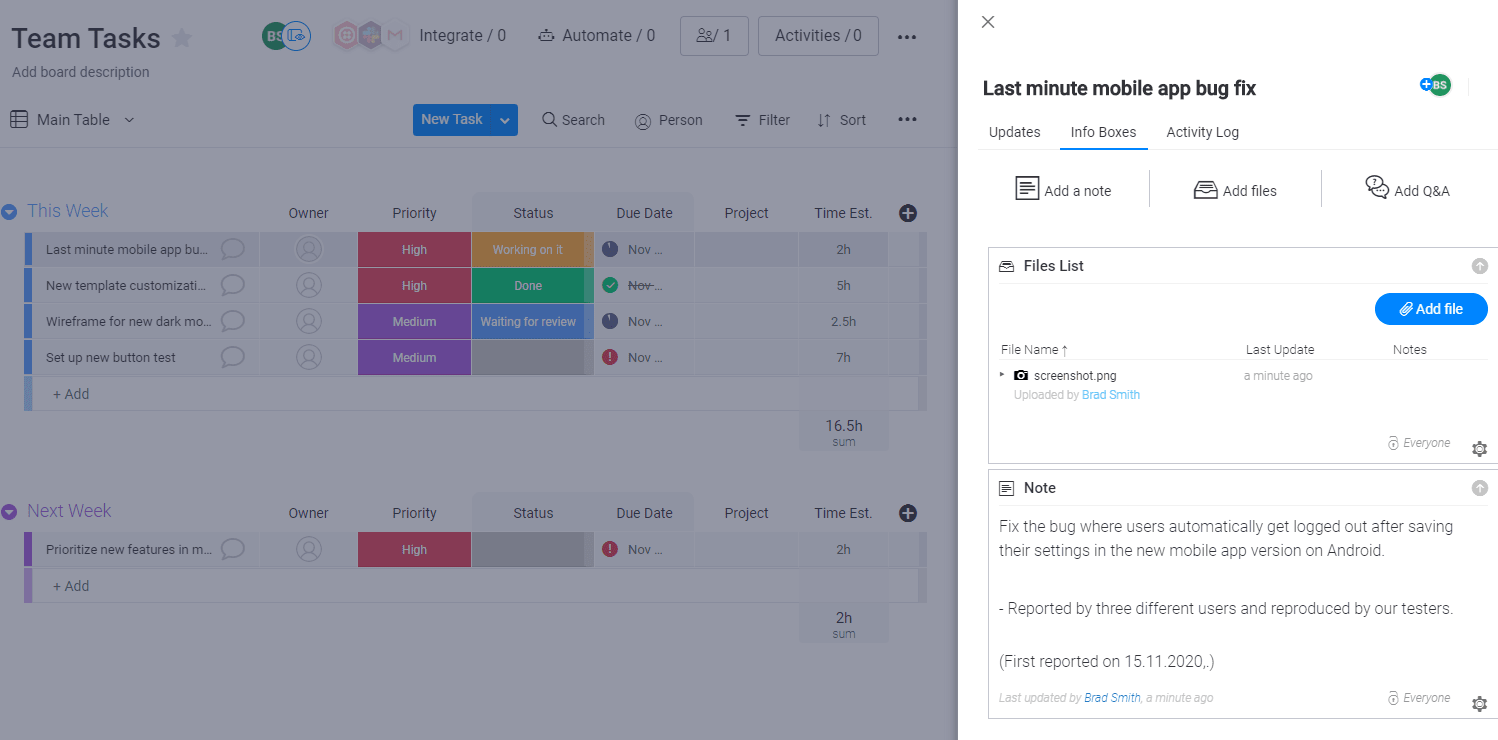
Or it could be something as simple as photocopying the latest brochure for distribution.
Single tasks are typically assigned to a single person or team, while the larger project could be a company-wide endeavor.
The task may or may not include a start and end date or a series of subtasks—this all depends on the complexity of the project at hand, which could be related to industry.
How do you break down a project into smaller tasks?
Even long term Scrum projects that last 11.6 weeks on average make use of task management to get their work done efficiently and effectively.
Part of task management includes creating manageable workloads, considering task dependencies, and of course, communicating across teams to avoid double work or roadblocks.
To avoid these issues, you need some way to break down the high-level project deliverables and goals into tangible tasks.
In the next section, we’ll show you two of the most popular methodologies, Waterfall, and Scrum.
Work Breakdown Structure
The work breakdown structure (WBS) is the official method of breaking down projects in the PMI Guidebook.
To figure out how to break the entire project into tasks, you first need to divide it into the actual deliverables required to hand over the final product or result to the client.
For example, if you’re planning to make a mountain bike, you can break that down into the frame, handlebars, pedals, wheels, chains, and so on.
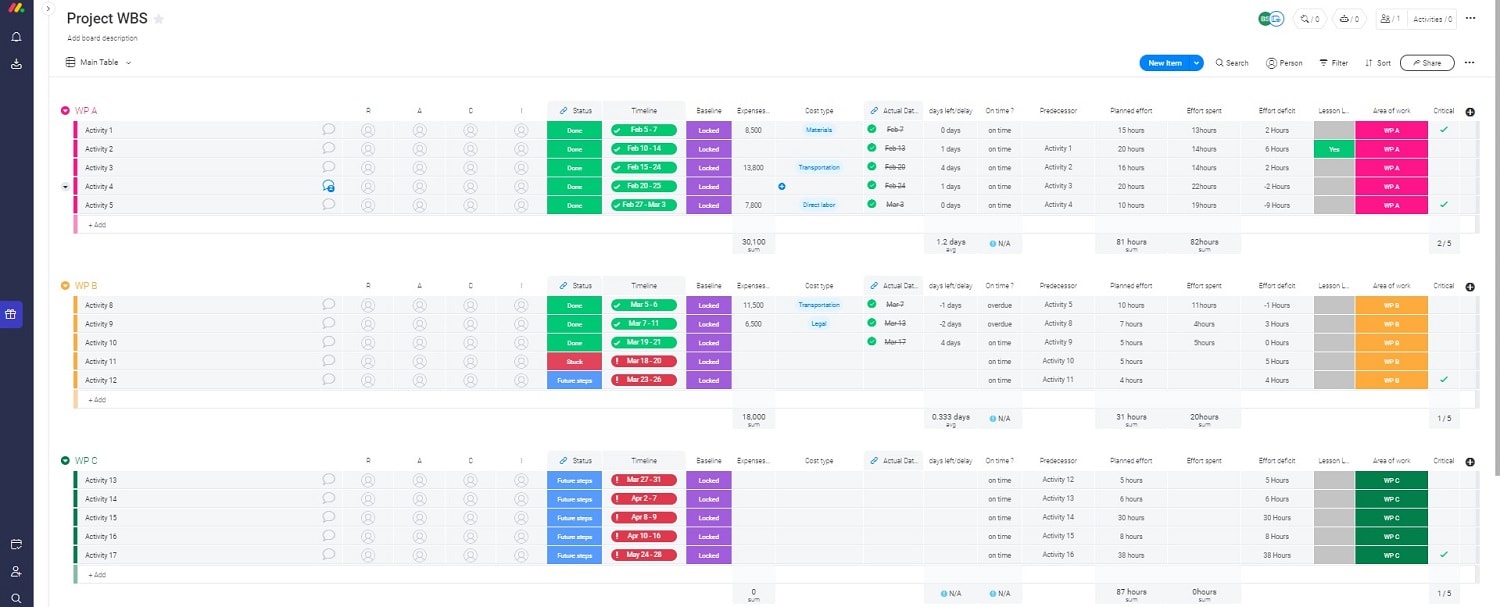
( Image Source )
You also need to work out the dependencies of the project (aka which deliverables require another one for completion).
If we were to simplify the WBS, the section on manufacturing the bike frame might look something like this.

Of course, each item contains multiple tasks such as sourcing vendors, reviewing designs, picking materials, and more.
But if you assign these tasks to teams who have the necessary skills to complete all of them, that’s what the top-level plan might look like.
If you use an Agile framework, like Scrum, you won’t bother breaking down the entire project into detailed tasks at an early stage. Avoiding this large-scale exercise in prediction is one of the primary principles of Agile.
Instead, you’ll focus on planning out a deliverable increment of your product in Scrum sprints . These are 2–4 week periods of focused work dedicated to delivering a working product version of the final deliverable.
The basis for planning out these iterations is a backlog of features or user stories (functionality from the user’s perspective). You may also have a product roadmap to outline the long-term product direction as well.
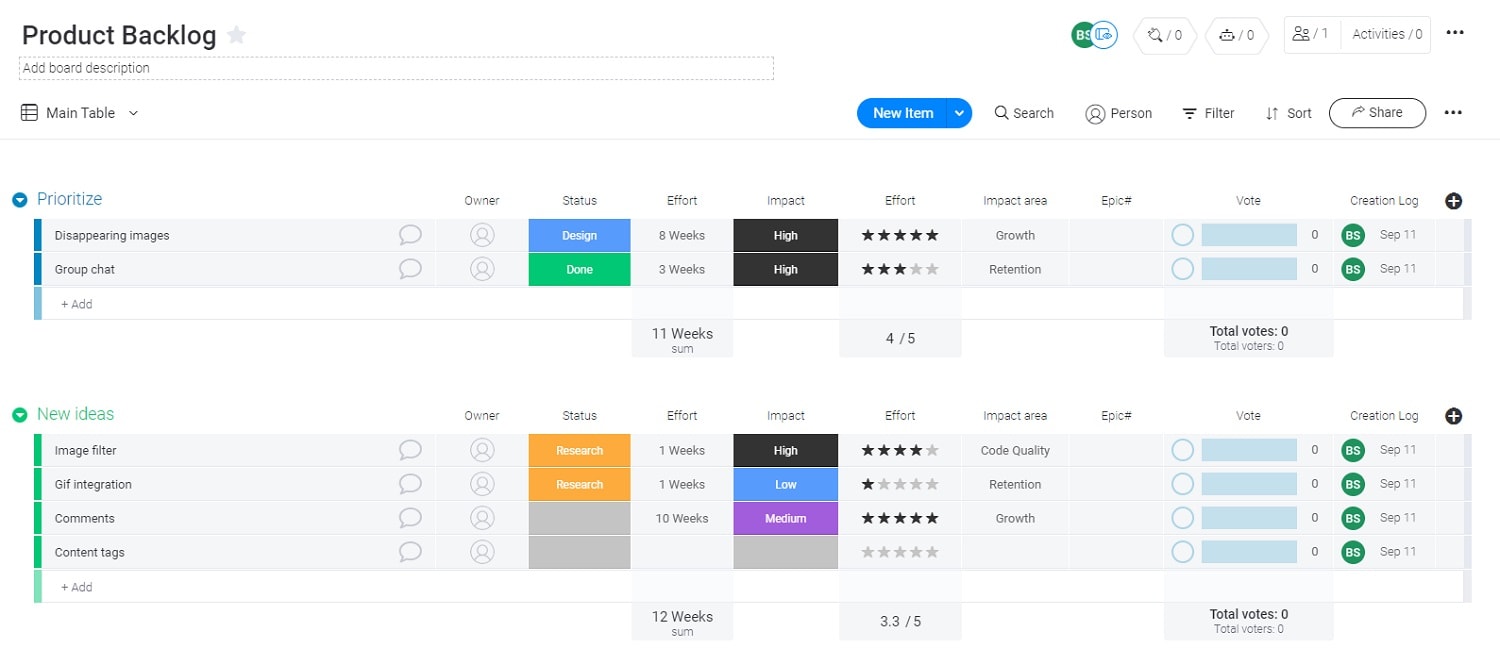
The product backlog is continually pruned and optimized before, during, and after sprints. Even if you’re not planning software projects, you can often single out elements that you can deliver in increments.
Before each Sprint, you meet with your team and stakeholders (invested parties) to discuss which user stories are the most important. You select a few items and create a dedicated sprint backlog .
Each user story is then further divided into tasks, and team members take ownership of the specific tasks they can handle.
It’s not ideal for all organizations or projects, but it’s an antidote against micromanagement in complex projects.
What size should a project task be?
So how granular should you get? What should the scope and length of the task in your project be?
It depends on the size of your project and your PM framework, but here are some rules of thumb.
The 8/80 rule for WBS
In traditional project management, a rule of thumb is that no task should be shorter than 8 hours or longer than 80 hours in the WBS.
That’s why the PMI recommends keeping tasks between 20–80 hours in the WBS.
Your individual teams can then have more granular task boards to manage their own to-do lists and/or break 2-week tasks down into daily sub-tasks.
Task length in Scrum
While user stories generally have no specified length, they’re often broken down into manageable chunks, usually one workday or less.
The official Scrum Guide doesn’t use the word tasks, but instead uses the term work unit:
“ Work planned for the first days of the Sprint by the Development Team is decomposed by the end of this meeting, often to units of one day or less. ”
On a Scrum board , you can use story points (at monday.com, we equate 1 SP to a workday) to estimate the length of the task.
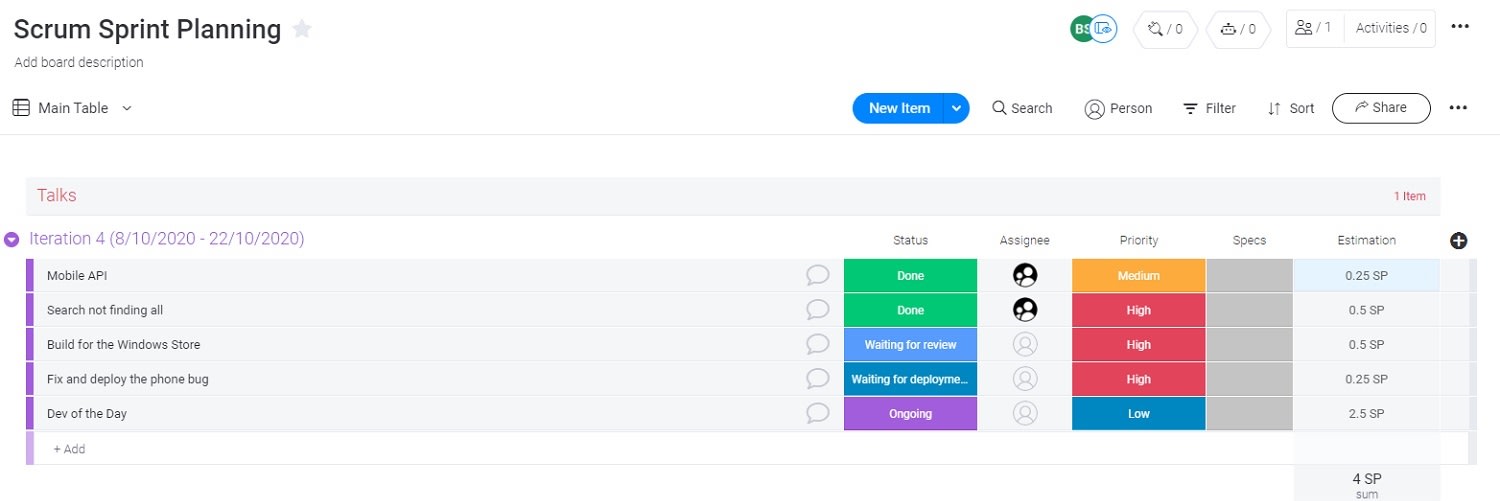
Tasks shouldn’t require more than one resource
When you break down deliverables into individual tasks, time isn’t the only consideration. The best approach is to make sure the person (or resource) who’s assigned the task can complete it from start to finish.
For example, a graphic designer could create a wireframe for an app, but wouldn’t be able to create a working prototype.
So you should split the larger deliverable of a working feature prototype into wireframe/design and development (at the very least).
For larger companies, a resource could be an entire team that includes designers, developers, and software testers. In which case, you don’t have to get as granular when planning and assigning tasks.
Accurately estimating task durations
The best way to predict the duration of tasks is to involve the actual resources who will handle the task in the planning process.
You don’t need to switch to Agile or Scrum to make this happen. You just need to involve the actual project implementers in the planning process, not just management.
Not only can they help with task durations, but they can also help with dependencies and expecting potential bottlenecks.
What is the best way to organize project tasks?
There are hundreds of different frameworks and methods for managing projects and breaking them down into tasks.
A few stand out because of their efficiency and ease of adoption and have become popular as a result.
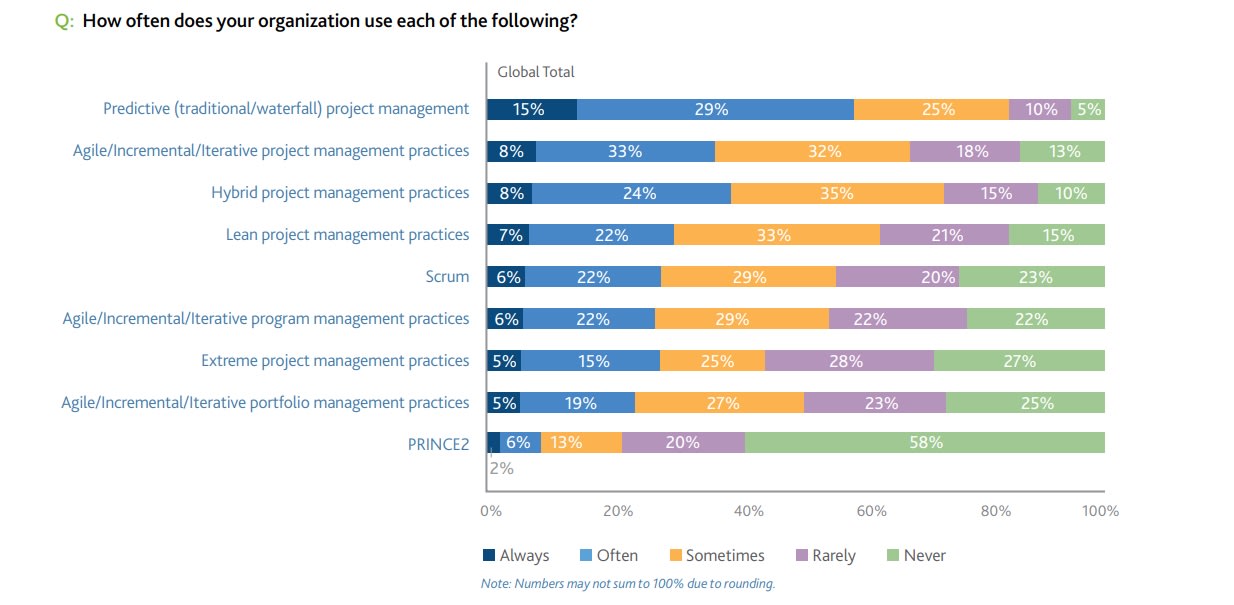
Let’s take a closer look at these industry-leading options.
Waterfall refers to the traditional “predictive” project management approach. It’s called predictive because you plan every phase of the project from start to finish before even getting started.
The reason it’s called waterfall is that the projects are planned to follow a sequential order.
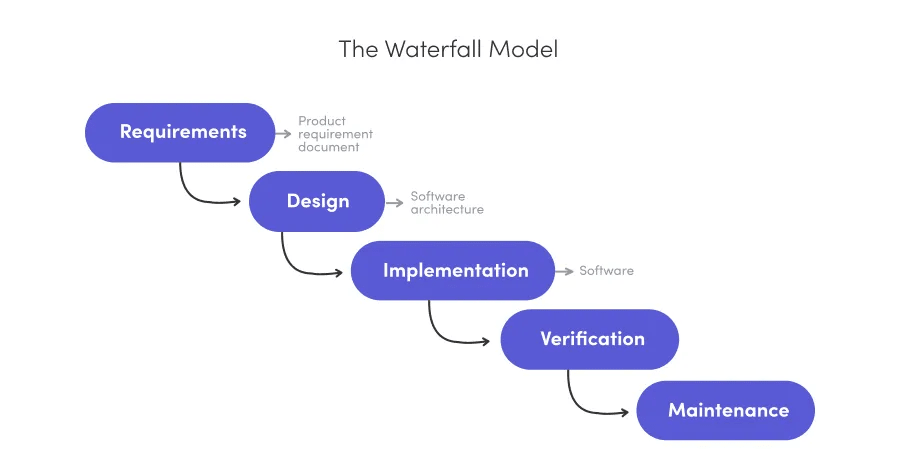
First, you start out by figuring out the requirements of the project. What deliverables do you need to deliver a finished product?
Then you move on to designing and creating (implementing) it. Finally, you verify that the product works as intended, and launch it. The last stage includes the long-term maintenance of the product.
While berating waterfall is a popular pastime among younger management professionals, it has its place.
For physical products with a lot of dependencies and high costs associated with actual production time, mapping out the entire project in detail can be the best approach.
Instead of a specific methodology, Agile outlines a core set of values and principles to apply to your projects. As a result, Agile is an umbrella term that covers many different methodologies and frameworks .
The most famous principle is to deliver working iterations of your project frequently. That’s in contrast to planning out an entire product from start to finish like with waterfall.
Lean, like Agile, is not a specific framework that details a project management approach. Instead, it refers to a management philosophy with a core set of principles.
The focus of Lean is eliminating waste in processes throughout each stage of production. The execution is what controls the outcome, after all.
Fixing bottlenecks between departments to speed up the final assembly is a good example.
Not to be confused with Agile, which is more about high-level concepts and principles, Scrum is an actual framework for project management.
It outlines clear rules, meetings (ceremonies), and deliverables (artifacts), not just values.
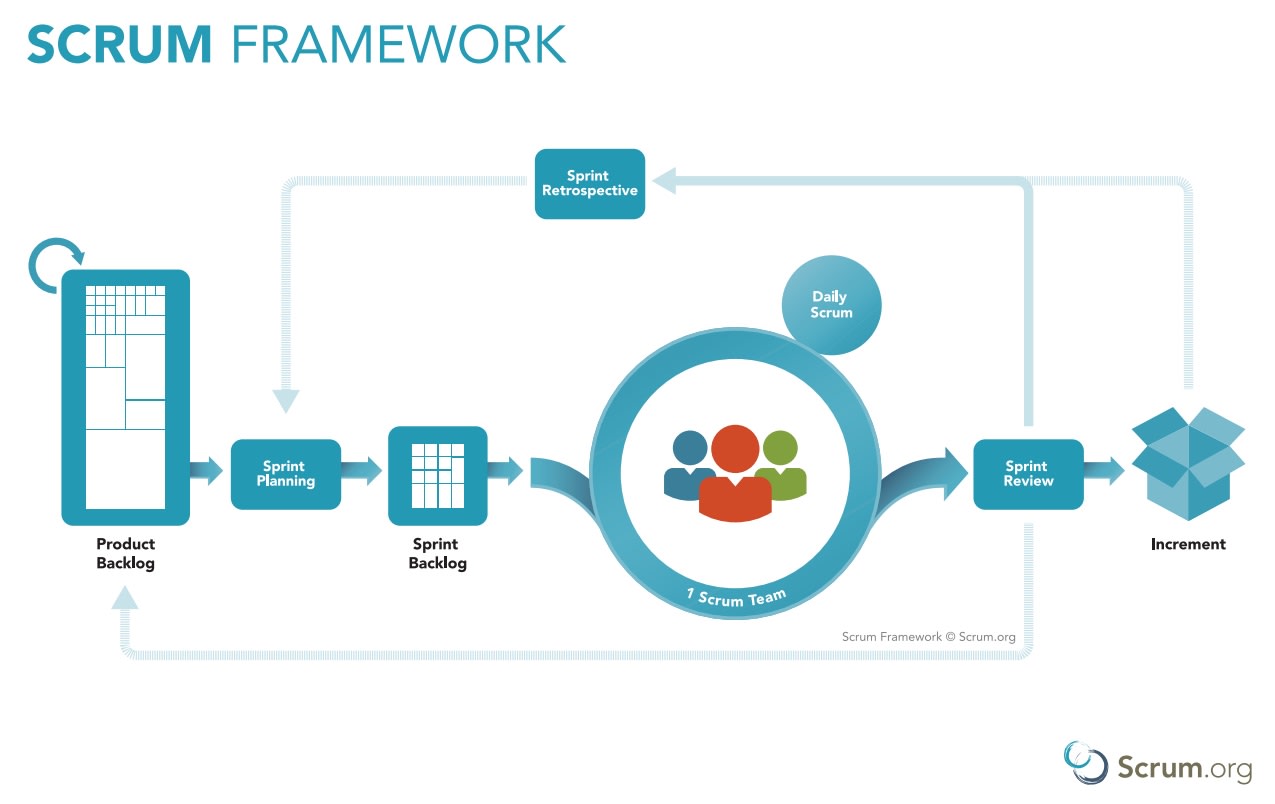
For example, Scrum teams should only include a maximum of 9 regular team members. Daily Scrum meetings should only last 15 minutes.
The entire process of designing and completing a sprint is laid out in detail. That’s what makes the Scrum framework so useful for teams that want to implement more Agile principles into practice.
How to use a project management platform for effective task management
Instead of slowing down your managers and teams with an inefficient process, take advantage of the latest task management software .
monday.com is a digital workspace with all the functionality a project manager could ever want, wrapped in a package that’s actually easy to learn and use.
Pick the framework or methodology you want to work with
If you want to reach a completely new target level of productivity, basic task management won’t cut it. You need to introduce a project management framework that goes beyond daily tasks.
Luckily, monday.com makes it easy to make the switch. We offer dedicated templates for everything from WBS to Scrum.
Develop the high-level project roadmap
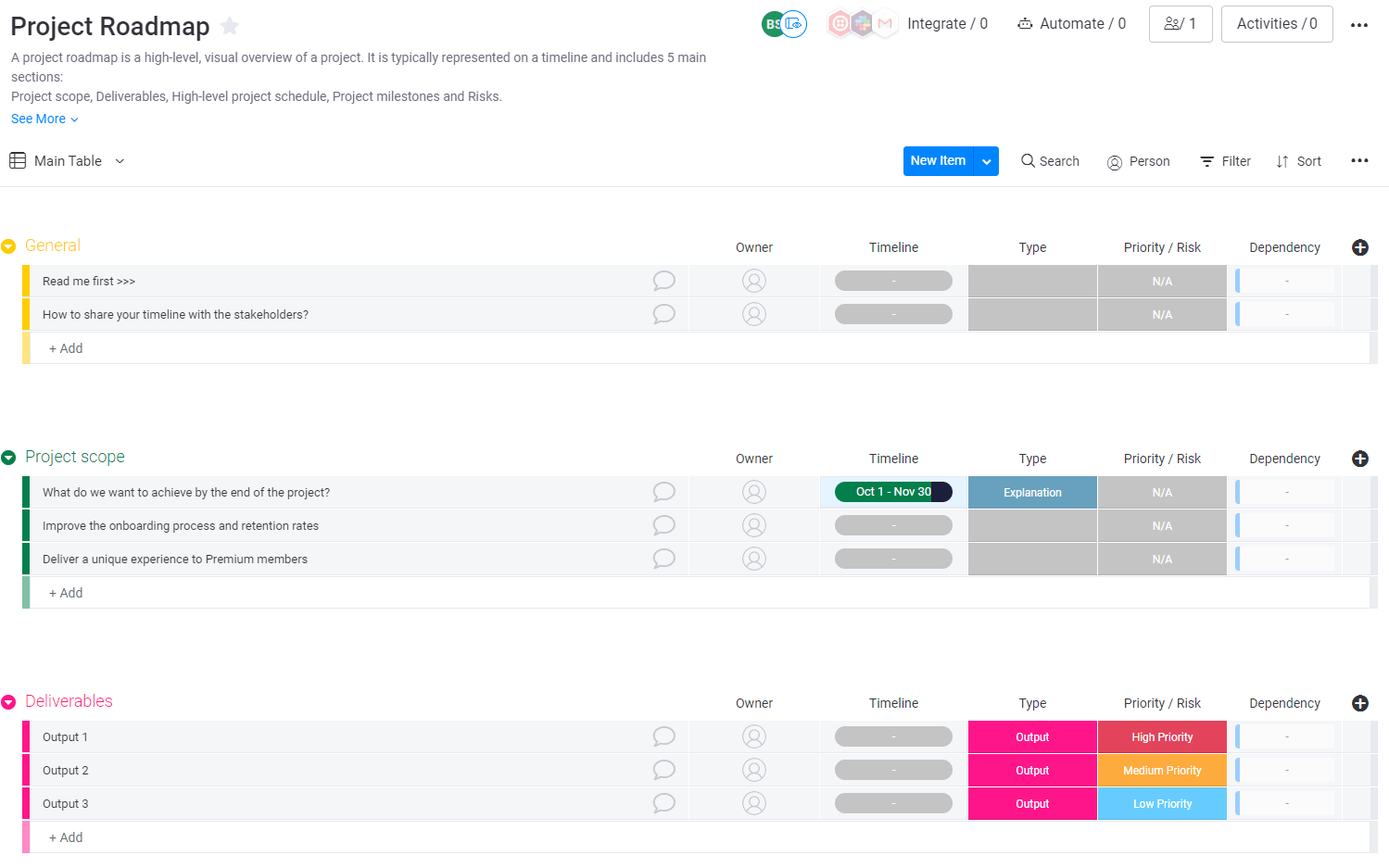
For consistent results, you should develop a high-level project roadmap. It will help guide all decisions and priorities as the project progresses.
Get more granular with a WBS and other task boards
This is where you break the larger goals into smaller deliverables and start to establish the workload for each team or department that’s involved.
It should outline the overall process but may not specify every activity or task, depending on the scale of the project.
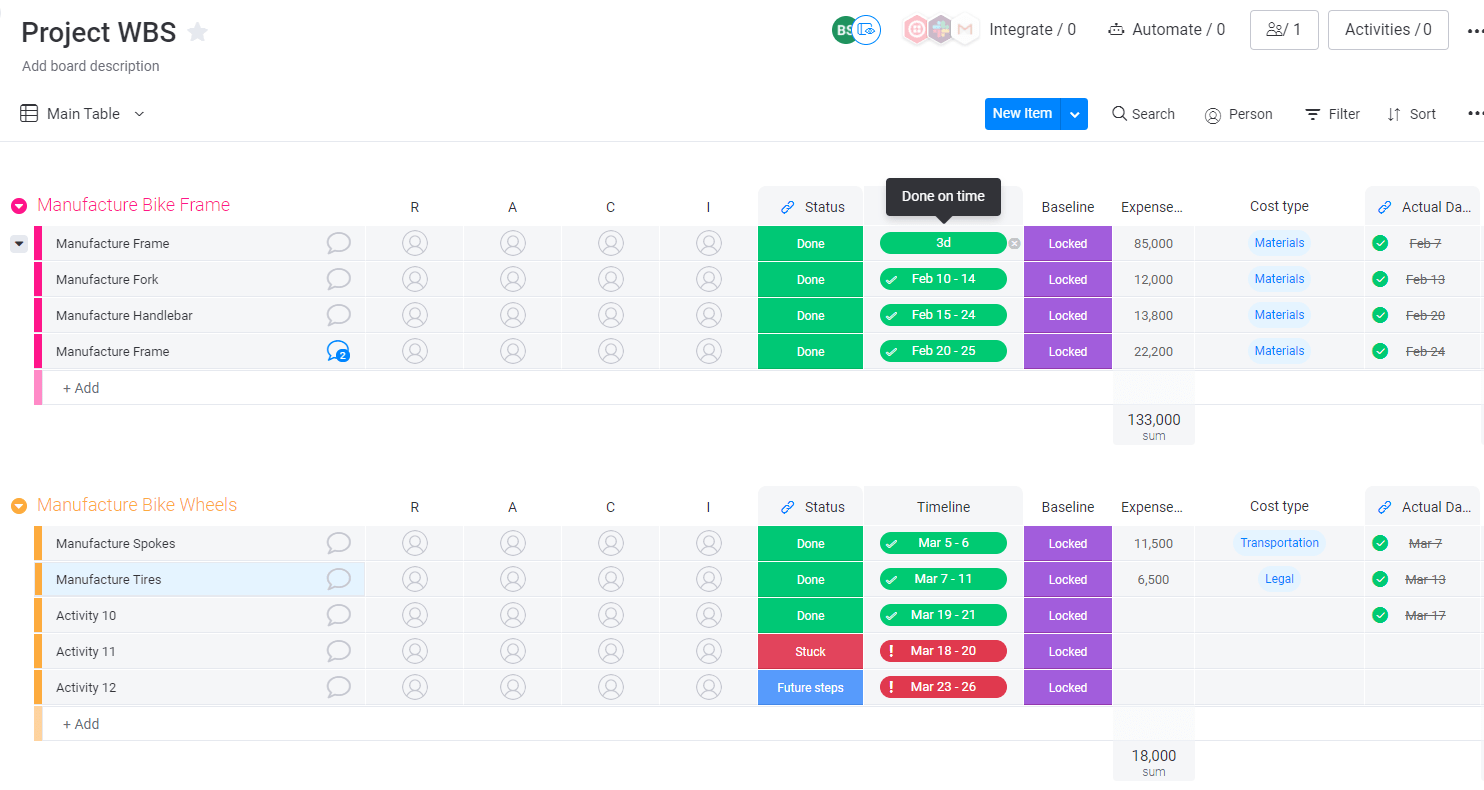
But it’s not the best for planning individual tasks within the involved teams or departments.
Which is why monday.com also offers more basic task boards that these teams can use to manage the day-to-day.
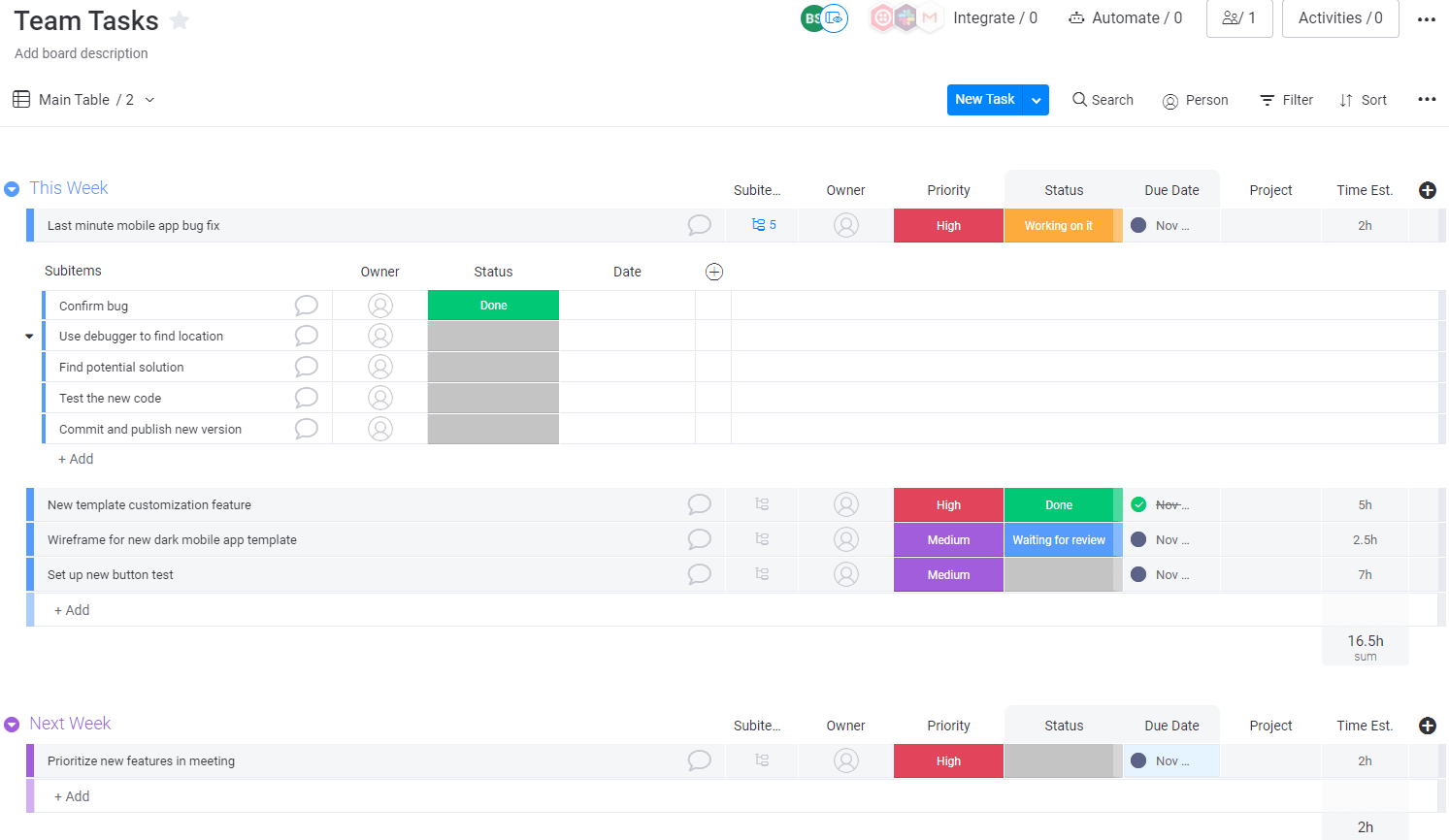
You can easily divide larger items into smaller subtasks and assign them as well.
Use integrations and automations to automate menial tasks
If you want to perfect your workflow , it’s not enough to create some new task boards. You also need to eliminate repetitive menial tasks.
For example, with our smart integrations, you can automatically update a card or create a new task when you receive an email or message.
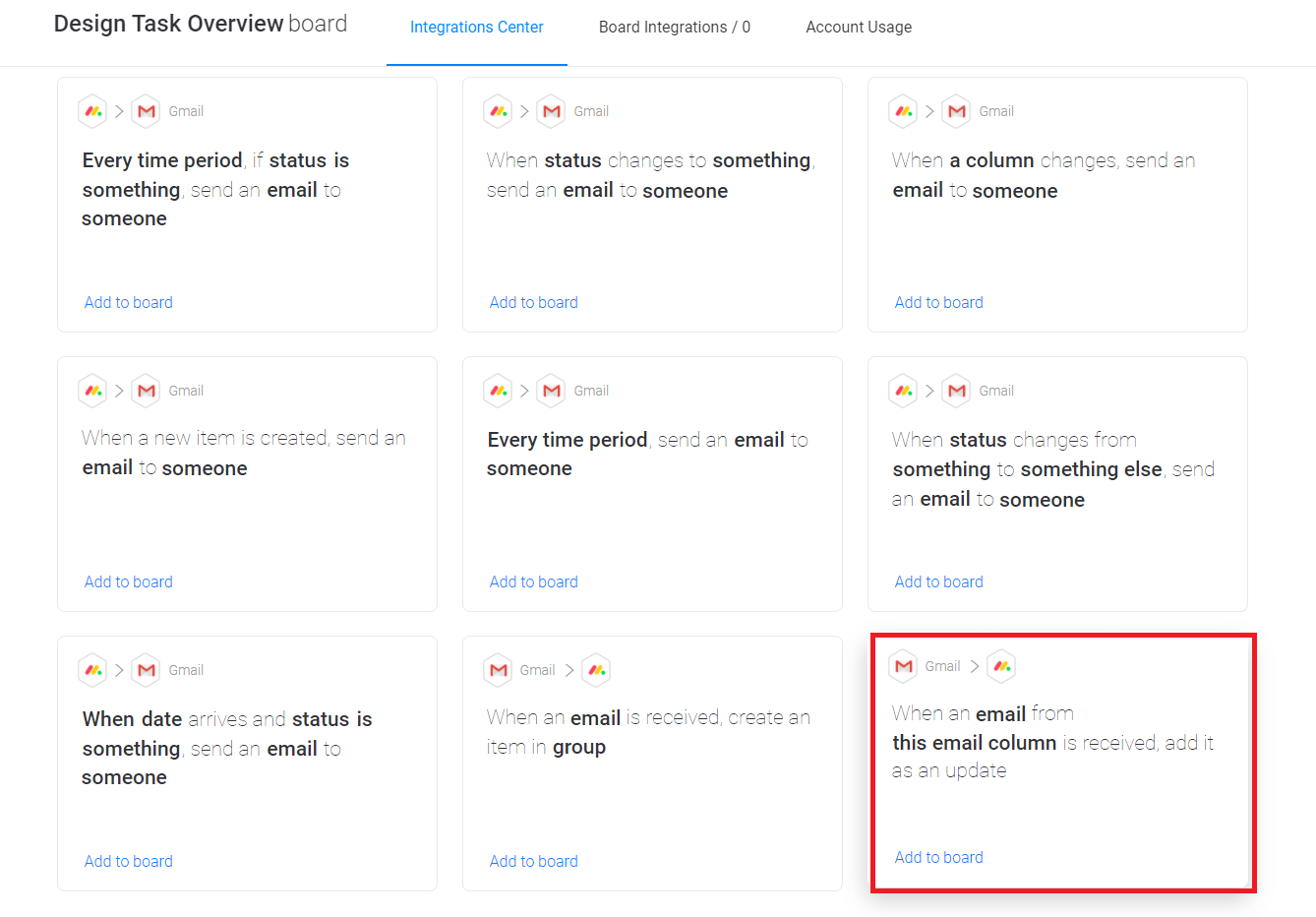
It’s a useful feature for a wide variety of teams and use-cases. For example, your software team could get a new task with every bug report.
By automating menial tasks, you give your managers and team the time and space to focus on crucial high-level decisions.
Keep managers up to speed with dashboards and reports
Want to see at a glance if tasks are being completed on schedule, or which people (or teams) are available for last-minute work?
You can easily create and customize a dashboard that will give your managers instant access to all the information they need.
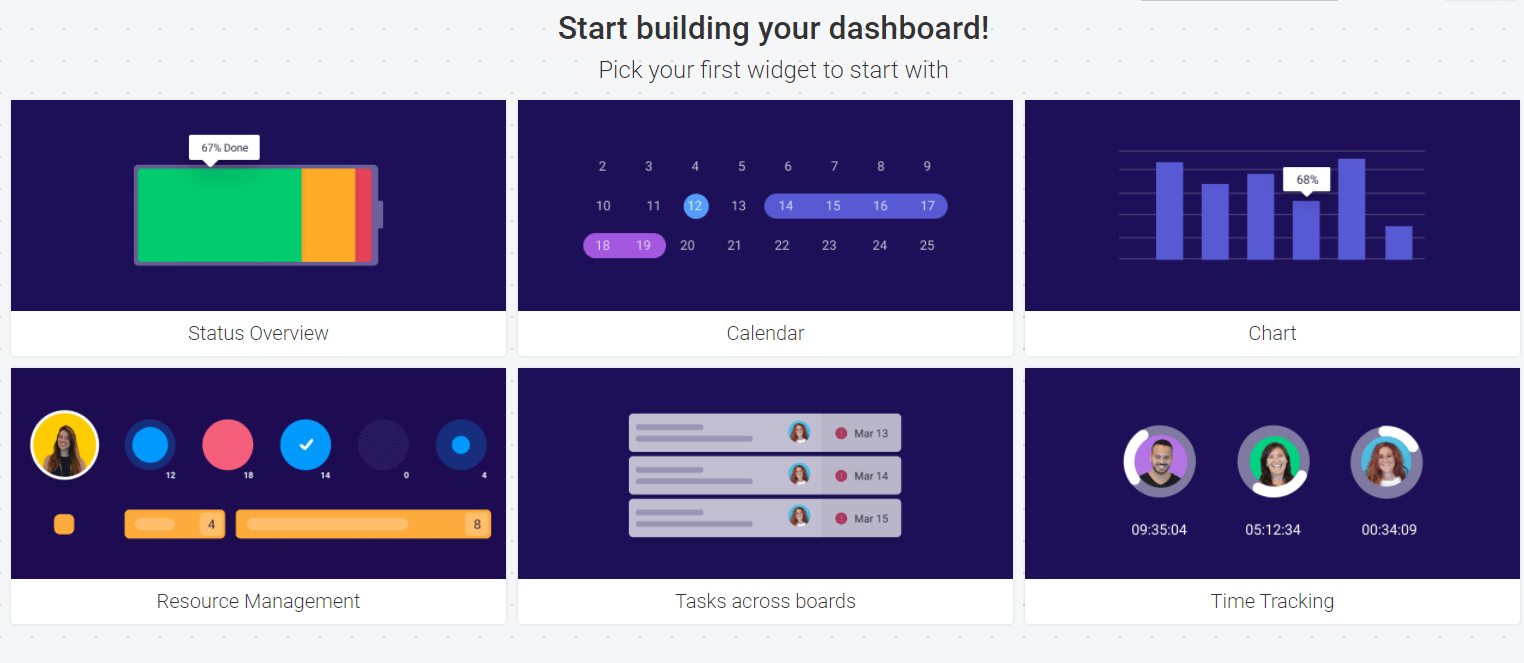
Master your tasks
Breaking down a project into tasks and assigning them effectively requires a bit of balance.
Finding the framework that works best for your industry and internal workflows and pairing them with the tips above can help you find the happy medium of management and autonomy that will allow your teams to thrive.
Whichever you choose, monday.com has the right templates and tools to help your projects succeed.

Assignment vs. Project — What's the Difference?
Difference Between Assignment and Project
Table of contents, key differences, comparison chart, compare with definitions, common curiosities, can assignments be used to assess understanding or proficiency in a subject, do projects typically involve extensive research, planning, and execution, is an assignment a specific task or piece of work allocated to someone, is the scope of an assignment typically more focused and specific than that of a project, is a project a larger and more complex undertaking than an assignment, do projects often encourage collaborative efforts and integration of various skills, can a project require more time, resources, and effort compared to an assignment, is an assignment usually of shorter duration compared to a project, can projects involve multiple stages and components, can an assignment have clear and defined objectives, share your discovery.

Author Spotlight
Popular Comparisons

Trending Comparisons

New Comparisons

Trending Terms


Assignment fields
The Assignment fields indicate whether the row is an assignment row, rather than a task or resource row.
There are several categories of Assignment fields.
Data Type Yes/No
Assignment (task field)
Entry Type Calculated
How Calculated If the row is an assignment row, the Assignment field contains Yes. If not, the Assignment field contains No. The Assignment field for tasks always contains No.
Best Uses The Task Usage view displays assignment rows, which indicate which resources are assigned to the task. Add the Assignment field to the sheet portion of the Task Usage view when you want to display whether the field is an assignment row. Filter for the Assignment field when you want to see only assignment rows (Assignment = Yes), or when you want to exclude assignment rows (Assignment = No).
Example In the Task Usage view, you want to see only assignment rows for assignments that have more than 80 hours of work. In the Filter Definition dialog box, you filter for all Assignment fields equal to Yes together with Work fields that have values greater than 80 hours.
Assignment (resource field)
How Calculated If the row is an assignment row, the Assignment field contains Yes. If not, the Assignment field contains No. The Assignment field for resources always contains No.
Best Uses The Resource Usage view displays assignment rows, which indicate which tasks are assigned to the resource. Add the Assignment field to the sheet portion of the Resource Usage view when you want to display whether the field is an assignment row. Filter for the Assignment field when you want to see only assignment rows (Assignment = Yes), or when you want to exclude assignment rows (Assignment = No).
Example In the Resource Usage view, you want to see only assignment rows for assignments that have more than 80 hours of work. In the Filter Definition dialog box, you filter for all Assignment fields equal to Yes together with Work fields that have values greater than 80 hours.
Assignment (assignment field)
How Calculated If the row is an assignment row, the Assignment field contains Yes. If not, the Assignment field contains No. The Assignment field for assignments always contains Yes.
Best Uses The Task Usage and Resource Usage views display assignment rows. In the Task Usage view, the assignment rows indicate which resources are assigned to the task. In the Resource Usage view, the assignment rows indicate which tasks are assigned to the resource. Add the Assignment field to the sheet portion of the Task Usage or Resource Usage view when you want to display whether the row is an assignment row. Filter for the Assignment field when you want to see only assignment rows (Assignment = Yes), or when you want to exclude assignment rows (Assignment = No).

Need more help?
Want more options.
Explore subscription benefits, browse training courses, learn how to secure your device, and more.

Microsoft 365 subscription benefits

Microsoft 365 training

Microsoft security

Accessibility center
Communities help you ask and answer questions, give feedback, and hear from experts with rich knowledge.

Ask the Microsoft Community

Microsoft Tech Community

Windows Insiders
Microsoft 365 Insiders
Was this information helpful?
Thank you for your feedback.

- How-to Guides
Tips for Students: Writing Project Management Assignments
by MyMG Team · Published March 23, 2020 · Updated July 4, 2024

Is it confusing for you to kickstart the writing process for your project management assignment? Does all that jargon like sustainability strategies, project feasibility, or risk mitigation make you feel stressed?
What is the best way to highlight your challenging project management topic acceptably?
‘Phew, what a challenging paper! How can I find a professional writer to deal with these boring assignments?”
Ok, we hear you. You can do it online in a matter of minutes. In fact, assignment writing help services can take all your project management paper worries away and deliver you a custom essay or even a 5-star dissertation without any hassle for you.
Sounds fantastic? That’s exactly what they do.
“Ok, cool. Is this a reliable way to deal with my papers?” Sure. Unless you are super lazy and want to turn them in without any modifications.
“What do you mean?” If you want to avoid any troubles in your college or university and have no time/desire to write your assignment on your own, you can look for expert help online.
However, once you get a well-written paper on your topic from the expert writer in that subject area, you need to rewrite it and modify it to some extent.
If you do this, nobody will ever accuse you of cheating or plagiarism, and you’ll save tons of time instead of completing your assignment from scratch.
Now, let’s explore the top tips for writing your project management assignments.
Get Enough Time for Writing
Essay writing is an essential academic skill. To create amazing papers, it’s crucial to have a great essay writing competence. How do you get it? Through practice. Write often. Write a lot.
One of the golden rules of writing any kind of essay is to make sure you get enough time in your schedule for research and writing.
Understand that you need some time to complete the work without being in a rush. Rarely, you can come up with an exceptional essay overnight. For this, you need to be really motivated, inspired and loaded with facts, arguments, and brilliant ideas.
Of course, there needs to be adequate time for choosing a topic, doing the research, reading all the materials and taking notes, gathering the notes into a logical order to form an outline, and writing the essay. Without doing all these things, you won’t be able to submit a top-grade paper on time.
Once you finish writing your paper, you still need to put in some work. What does it mean? Your essay needs to be proofread, edited, and polished up.
Every student works at a different pace, so discovering how much time is needed is an individual thing, and the first most crucial essay writing skill.
Choosing a topic
This step is central to a knockout essay. That’s because the topic can make or break the article. Choose it carefully if you have such an opportunity. If the instructor has assigned a topic, then it is up to you to find a perfect angle on the topic to base your essay on.
Photo by Dollar Gill on Unsplash
Research and taking notes
The research phase is where the student dives into what others have written about the general topic. This step could be done before step 2 if the student needs help narrowing down the topic or the angle on the topic.
Jotting down notes during the reading and referencing the source for the notes will save tons of time later on in writing.
Forming the Outline and Writing the Essay
The notes are organized into groups that logically fit together. A description for each set is like a subheading. These can be arranged in chronological order or organized in a fashion that flows well from one idea to the next. This is the outline of the body of the essay.
Writing the essay consists of filling in the details for each of the sections in the outline. It includes writing a captivating opening paragraph and a memorable summary at the end.
Proofreading and editing
Unfortunately, this important step is often missed. Even the best essays will fail without detailed proofreading and in-depth editing.
It is best if this step is done by another person, as it is easy for a writer to overlook their own mistakes in assignment writing.
The proofreader and editor should be someone who is really good at writing, not just a neighbour or friend because they are available and free.
So now you know all the basic steps that you need to take to be able to submit a winning project management assignment on time. Don’t just sleep on these tips. Put them into work and you will see the results.
Alternatively, you may always choose a service for you to assist.
Tags: project manager student tasks writing
We are a small group of professionals specializing in project management. We wish you success in your career, business, studies, or whatever else you think is worth your time and effort—we are pleased to know that our advice is helpful.
- Next story How do HR personnel change workplace culture? Five Tips to change it today too
- Previous story How to Stay Organized: Five Ways for Project Managers
You may also like...
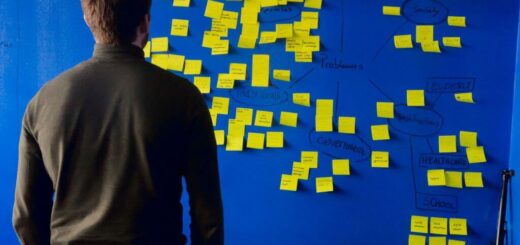
Writing an Efficient Resource Breakdown Structure (RBS) for Your Project
October 19, 2020
by Bridgette Hernandez · Published October 19, 2020 · Last modified June 26, 2023

Key Duties of Executive Teams and Managers in IT Projects
February 3, 2011
by Eric Morkovich · Published February 3, 2011 · Last modified June 26, 2023

How to Write an Ace Project Management CV: Tips and Tricks
April 15, 2017
by Eric Morkovich · Published April 15, 2017 · Last modified July 3, 2024
Worth Reading

How to Fail a Project, or What You Shouldn’t Do When Managing Your Project
October 13, 2010

Business Banking Checklist
July 18, 2011

Best Practices of Hiring Talented Software Developers
April 21, 2020

5 Reasons Why MMORPGs are So Hard to Make
August 18, 2023

What can you do with a business management degree?
November 4, 2019
#ezw_tco-3 .ez-toc-title{ font-size: 120%; ; ; } #ezw_tco-3 .ez-toc-widget-container ul.ez-toc-list li.active{ background-color: #ededed; } Table of Contents Toggle

Business & Finance
5 Best Practices for Building and Nurturing Customer Trust in Retail

Serial Entrepreneurs in Social Ventures: Catalysts for Positive Change

Project initiation stage – Project Initiation Document (PID). Duties of project owner and project team

Organizing Procurement and Purchasing Activities in a Project

Two Common Mistakes in Project Procurement Contracts

Project Sponsor – The Role and Responsibilities
- Individual College Courses Undergraduate Certificates Graduate Certificates Associate Degrees Bachelor's Degrees Master's Degrees " tabindex="0"> View All Undergraduate Degrees > " tabindex="0"> View All Graduate Degrees > " tabindex="0"> View All Degree Programs >
- Accounting Business Human Resource Management Sales and Marketing Project Management Master’s of Project Management (MPM) Master's of Business Administration (MBA) " tabindex="0"> View All Business Programs >
- Artificial Intelligence Cyber Security Engineering Technology Information Technology and Networking Media Arts and Technology Software and Information Systems Website Design Certificate " tabindex="0"> View All Tech Certificates > " tabindex="0"> View All Technology Programs >
- Health Administration Health Information Technology Health Information Management Medical Billing and Coding " tabindex="0"> View All Health Programs >
- Understand Tuition Costs & Fees Payment Plans Student Loans
- Financial Aid How to Apply for Financial Aid Scholarship & Grants State-funded Programs Employer Tuition Assistance Military Benefits Alumni & Family Tuition Savings Contact Us
- Undergraduate Graduate Transfer Student International Military & Veteran High School Graduates Adult Learners
- Admission Process Our Academic Standards Our Faculty Accreditations Academic Catalogs Prior Learning Assessment School + Work Balance Understand Tuition Costs & Fees Contact Us
- Online Education How Online Classes Work? Find Campus Locations Learning with Technology
- Student Success & Testimonials Academic Calendar Academic Catalogs Alumni Network
- Our Guiding Principles Our Commitment Our Support Financial Aid School + Work Balance Student Online Tools DeVry Blog Disability Services Contact Us
- Career Resources Career Services How to Choose a Career Careers in Business Careers in Healthcare Careers in Technology
- About DeVry University Keller Graduate School of Management Accreditations Center for Cybersecurity
- Our Faculty Student Success & Testimonials AI Resource Center
- DeVry Blog Find Campus Locations Contact Us
- Request Info Apply Now
Degrees & Programs
- By Degree Level Individual College Courses Undergraduate Certificates Graduate Certificates Associate Degrees Bachelor's Degrees Master's Degrees View All Undergraduate Degrees > View All Graduate Degrees > View All Degree Programs >
- Business Accounting Business Human Resource Management Sales and Marketing Project Management Master’s of Project Management (MPM) Master's of Business Administration (MBA) View All Business Programs >
- Healthcare Health Administration Health Information Technology Health Information Management Medical Billing and Coding View All Health Programs >
- Technology Artificial Intelligence Cyber Security Engineering Technology Information Technology and Networking Media Arts and Technology Software and Information Systems Website Design Certificate View All Tech Certificates > View All Technology Programs >
- Keller Graduate School of Management Master's of Business Administration (MBA) Master's of Accounting and Finance Master's of Human Resource Master's of Information Technology Master's of Project Management View All Graduate Programs >
Tuition & Financial Aid
- Tuition & Expenses Understand Tuition Costs & Fees Payment Plans Student Loans
- Paying for College Financial Aid How to Apply for Financial Aid Scholarship & Grants State-funded Programs Employer Tuition Assistance Military Benefits Alumni & Family Tuition Savings Contact Us
- By Applicant Type Undergraduate Graduate Transfer Student International Military & Veteran High School Graduates Adult Learners
- Admission Assistance Admission Process Our Academic Standards Our Faculty Accreditations Academic Catalogs Prior Learning Assessment School + Work Balance Understand Tuition Costs & Fees Contact Us
- Student Experience
- Learning Experience Online Education How Online Classes Work? Find Campus Locations Learning with Technology
- Academic Journey Student Success & Testimonials Academic Calendar Academic Catalogs Alumni Network
- Student CARE Our Guiding Principles Our Commitment Our Support Financial Aid School + Work Balance Student Online Tools DeVry Blog Disability Services Contact Us
- Career Support Career Resources Career Services How to Choose a Career Careers in Business Careers in Healthcare Careers in Technology
About DeVry
- AI Resource Center
- Workforce Solutions
- Transfer Students
- Student Portal Login
855.890.3001
Have a question?
We are here to help. Connect with our DeVry University representatives.
Expand Your Horizons by Taking on Stretch Assignments

By DeVry University
November 18, 2021 5 min read
There's a reason why almost every video game has increasing levels of difficulties: to keep gamers at the edge of their seat, excited and curious about the challenges that lie ahead. No matter what their goals and ambitions are, people tend to crave adventure and new hurdles to overcome.
That's also the reason why taking on stretch assignments has become a new and appealing strategy for discovering new skills and abilities you never knew you had.
What Is a Stretch Assignment?
In its most basic sense, a stretch assignment is any kind of project or task that is beyond your current skill set or expertise. Usually, it can be a short-term activity or even a permanent venture into a new field that will provide you with challenging experiences meant to expand your growing list of abilities.
The keyword here is "stretch," which means that stretch assignments can extend your range of knowledge and help you unfold your hidden skills.
What Are the Benefits of Stretch Assignments?
Taking on a stretch assignment isn't just a step toward skill development — it's also a fun step toward individual progress and character development.
It Helps Build Up Your Resiliency in Tough Situations
Resiliency is that never-give-up attitude you need when you're in the middle of getting out of a tough situation. You can read books about grit and endurance, or even watch a documentary of a successful athlete who battled numerous injuries in his or her career. But there's no better way of improving your resiliency than being in a new environment filled with various hurdles to overcome.
Trying to overcome new challenges will help increase your resiliency level — even if there are times that lead to failure. The process is what counts, as acquiring new skills will get you out of your comfort zone and even help you build a new one. A stretch assignment will not just make the unfamiliar familiar to you, but it will also increase your endurance when another unexpected problem comes your way.
It Provides a Much-Needed Breather From the Routine
Nothing can exhaust you of your creativity and motivation more than being stuck in a routine where you do the same thing over and over for a long period of time. That is when we start to lose inspiration and the quality of our work decreases.
Stretch assignments will give you the chance to breathe in some fresh air and recharge your battery. After you finish a stretch assignment, you can go back to your original role, but this time you'll feel reenergized and inspired.
What Are Some Stretch Assignment Examples?
Stretch assignments can vary in type and duration, but here are some stretch assignment examples that may be found across different fields or industries:
Mentoring a Teammate or a New Member of the Group
Being great at what you do is one thing, but teaching someone to also be great at what you do takes another level of patience and commitment. Of course, it goes without saying that before you become a mentor, you have to become proficient in your own work first. It can take time — even years — to hone your skills.
When you become good at your job, and you know that you're ready for whatever challenges it might provide, then that knowledge will give you the confidence to be a mentor to a younger teammate or a new member of your group.
Assuming a Leadership Role
A stretch assignment can also help mold you into a great leader, as it doesn't just broaden your knowledge but can also enhance your interpersonal skills . These interpersonal skills can help you relate more to your team and interact with them, which, in turn, may help them respond well to your brand of leadership.
It may help your development to observe and study great leaders who came before you. Developing leadership skills can take time, and you can learn a lot by following the lead of your manager or of those you admire. The important thing is to not cheat the process. Stay patient and committed, and pursue the opportunity to lead when you think you're ready.
How Will You Ask Your Manager to Give You a Stretch Assignment?
If you feel like you're ready to move out of your comfort zone and take the next step, here's how you can approach your manager to ask for a stretch assignment:
Make Sure That You're Ready
When you ask your manager or supervisor to give you a stretch assignment, make sure that you're mentally and emotionally ready to take on a new task that is beyond your expertise. Stretch assignments will not just expand your skillset, but they can also test your patience and level of commitment. You can’t quit when the situation gets tough.
Come Up With a Plan on How to Help the Team
Sure, you are willing to learn a new role, but how could that help the team or the company move forward? Stretch assignments may be one of the best ways to grow individually, but remember that it’s also important to be a valuable asset to the team. Back up your stretch assignment request by laying out the ways where you think your new role can help your team achieve more success in the near future.
Ready to Expand Your Skillset?
With many businesses adapting to the technology-driven world, the way people work has also changed. Don't worry though — DeVry University and its Keller Graduate School of Management are here to help you stay at the top of the world of business. Grow your skillset by enrolling in either our Bachelor’s Degree in Business , which can be paired with one of four different specializations, or our Master's of Business Administration (MBA) 1 program that you can earn in as few as 10 courses 2 and the option to choose from 10 specializations.
Find out more about how DeVry's business programs can help you develop and pursue your vision of leadership.
8-Week Class Sessions
Classes start every 8 weeks.
Filter Blog Post Category
- Industry Insights
- Professional Development
- Work-Life-School
- DeVry Updates
- Diversity, Equity and Inclusion
- Student and Alumni Stories
- Program Area
Related Posts

Choosing the Perfect Resume Format for You

How to Write a Self-Evaluation
Related information.
By Degree Level
- Individual College Courses
- Undergraduate Certificates
- Graduate Certificates
- Associate Degrees
- Bachelor's Degrees
- Master's Degrees
- "> View All Undergraduate Degrees >
- "> View All Graduate Degrees >
- "> View All Degree Programs >
- Human Resource
- Sales and Marketing
- Project Management
- Master’s of Project Management (MPM)
- Master's of Business Administration (MBA)
- "> View All Business Programs >
- Health Administration
- Health Information Technology
- Health Information Management
- Medical Billing & Coding
- "> View All Health Programs >
- Artificial Intelligence
- Cyber Security
- Engineering Technology
- Media Arts and Technology
- Software and Information Systems
- Website Design Certificate
- "> View All Tech Certificates >
- "> View All Technology Programs >
Keller Graduate School of Management
- Master's of Business Administration
- Master's of Accounting and Finance
- Master's of Human Reosurces
- Master's of Information Technology
- Master's of Project Management
- "> View All Graduate Programs >
Tuition & Expenses
- Understand Tuition Costs & Fees
- Payment Plans
- Student Loans
Paying for College
- Financial Aid
- Scholarship & Grants
- State-funded Programs
- Employer Tuition Assistance
- Military Benefits
- Alumni & Family Tuition Savings
Admissions & Catalogs
- Admissions Overview
- Undergraduate Admissions
- Graduate Admissions
- Transfer Applicants
- Working Adult Applicants
- Academic Catalogs
Experience & Information
- Academic Calendar
- Transcript Requests
- Accountability Principles
- Title IX Information
- COVID-19 Updates and Online Resources
- About DeVry University
- Campus Locations
- Accreditation + State Authorization
- Student Testimonials
- Center for Cybersecurity
- " tabindex="0"> View All Undergraduate Degrees >
- " tabindex="0"> View All Graduate Degrees >
- " tabindex="0"> View All Degree Programs >
- " tabindex="0"> View All Business Programs >
- " tabindex="0"> View All Health Programs >
- " tabindex="0"> View All Tech Certificates >
- " tabindex="0"> View All Technology Programs >
- " tabindex="0"> View All Graduate Programs >
- Terms Of Service
- Privacy Policy
- California Employee Privacy Policy
- Careers at DeVry
- Accessibility Statement
- Student Consumer Information
- Student Complaint Procedure
- California State Disclosures
- California School Performance Fact Sheets
- DeVry University California BPPE Annual Report
- California Bureau for Private Postsecondary Education
In New York, DeVry University operates as DeVry College of New York. DeVry University is accredited by The Higher Learning Commission (HLC), www.hlcommission.org . The University’s Keller Graduate School of Management is included in this accreditation. DeVry is certified to operate by the State Council of Higher Education for Virginia. Arlington Campus: 1400 Crystal Dr., Ste. 120, Arlington, VA 22202. DeVry University is authorized for operation as a postsecondary educational institution by the Tennessee Higher Education Commission, www.tn.gov/thec . Lisle Campus: 4225 Naperville Rd, Suite 400, Lisle, IL 60532. Unresolved complaints may be reported to the Illinois Board of Higher Education through the online complaint system https://complaints.ibhe.org/ . View DeVry University’s complaint process https://www.devry.edu/compliance/student-complaint-procedure.html Program availability varies by location. In site-based programs, students will be required to take a substantial amount of coursework online to complete their program.
© DeVry Educational Development Corp. All rights reserved.
- Implementing Project Financial Management and Grants Management
Transaction Analysis for Project Planning Resource Assignments
Project application administrators can use the Transaction Analysis for Project Planning Resource Assignments report to analyze how a cost rate was calculated for project planning resource assignments. The report helps to identify causes where a cost rate can’t be determined or a cost rate value is not as expected.
Use the Transaction Analysis for Project Planning Resource Assignments Report to:
- Rate wasn’t found for the person or person job.
- Rate wasn’t found for the nonlabor transaction.
- Application can't find a costing rule for the labor transaction.
- A rate wasn't found for job X because the job doesn't exist in the job set or isn't mapped to another job in the job set.
- Was a labor costing override used?
- Was a project cost rate override used?
- Was the correct date-effective rate schedule entry used?
- Was the correct organization costing rule used for the expenditure organization?
- Was an actual cost rate or planning cost rate used?
Let’s look at an example that describes how a project application administrator uses the Transaction Analysis for Project Planning Resource Assignments Report to assist a project manager in troubleshooting a costing error in the financial project plan, budget, or forecast.
- A project manager encounters one or more costing errors when they create a project forecast. The project manager has to clear the errors before submitting the forecast for approval.
- The project manager chooses an error to investigate first, for example 'A raw cost rate wasn't found for the planning transaction'.
- Project name
- Financial plan type
- Plan version
- Planning resource
- Planning period
- The project manager sends the above details to their project application administrator to help resolve this issue so that they can successfully submit the forecast.
A project application administrator can then help resolve this issue in the following manner:
- Navigate to the Reports and Analytics work area.
- Click Browse Catalog .
- Navigate to Shared Folders > Projects > Projects Maintenance and open the Transaction Analysis for Project Planning Resource Assignments Report .
- Enter the parameter values provided by the project manager and click Apply . The application downloads the report output.
- Report Details - Displays report parameter values and runtime details, such as the date the report was run and by which user.
- Transaction Details - Provides a summary of key resource assignment attributes to assist analysis.
- Transaction Errors - Provides a summary of any existing errors or warnings relating to the resource assignment.
- Costing - Provides a detailed breakdown of cost processing and related setups.
- Cost Processing - Where a resource assignment is already costed, this section shows the outcomes of those successful events.
- To check whether the costing error reported in the application still exists. For example, since the error was raised another user may have fixed the costing setups, but has yet to revisit the resource assignment to clear the error.
- Where a transaction has already been costed, you can compare the simulated outcome to the existing cost outcomes. You can, for example, identify where there have been any changes in costing setups since the transaction was processed. For transactions created before the 22D release, you won't see the Costing Date and Costing Method for previous cost processing.
- Simulated Cost Processing Errors - Details any errors resulting from the simulated cost processing described above.
- Cost Processing Setups - Lists out all of the application setups that relate to each of the costing methods that are used to calculate raw costs.
- There are labor costing overrides for the person associated with the resource assignment, but they're not date effective as of the planning date.
- There are organization costing rules matching the expenditure business unit of the resource assignment, but they are not a match for the expenditure organization.
- The planning options for the plan version are configured to use planning rates, as opposed to actual rates.
- Depending on the root cause of the costing exception as identified above, the project application administrator can take the necessary corrective actions. For example, they could add a new organization costing rule for the relevant business unit and expenditure organization.
- After updating the relevant application configuration, the project application administrator can rerun the report and check the Simulated Cost Processing section, to see if the error is cleared.
- The project manager can then revisit their forecast (or budget or financial project plan, as applicable) to clear the error and successfully submit it for approval.
- Français
- Español
CANCELLED - Project Coordinator at subnational level – Western and Eastern Regions - 2 Positions
Advertised on behalf of.
Herat and Jalalabad provinces, AFGHANISTAN
Type of Contract :
Service Contract
Starting Date :
Application deadline :.
08-Jul-24 (Midnight New York, USA)
Post Level :
Duration of initial contract :, languages required :.
English
Expected Duration of Assignment :
UNDP is committed to achieving workforce diversity in terms of gender, nationality and culture. Individuals from minority groups, indigenous groups and persons with disabilities are equally encouraged to apply. All applications will be treated with the strictest confidence. UNDP does not tolerate sexual exploitation and abuse, any kind of harassment, including sexual harassment, and discrimination. All selected candidates will, therefore, undergo rigorous reference and background checks.
UN Women, grounded in the vision of equality enshrined in the Charter of the United Nations, works for the elimination of discrimination against women and girls; the empowerment of women; and the achievement of equality between women and men as partners and beneficiaries of development, human rights, humanitarian action and peace and security.
Afghanistan is one of the world’s most complex emergencies and the world’s largest humanitarian crisis. Afghan people are grappling with the impact of conflict, poverty, economic decline, and natural disasters. In this context, Afghan women and girls face unique vulnerabilities and require urgent support as gender inequality is interwoven with conflict dynamics and humanitarian needs. It is essential that Afghan women and girls can continue to shape the development of their country, and that their gains are protected. UN Women remains fully committed to supporting Afghan women and girls and to putting them at the center of the global response to the crisis in Afghanistan. UN Women has been in Afghanistan for two decades. UN Women’s programming approach is informed by analysis of the political, economic, and humanitarian situation, risks to and capacities of partner organizations, and needs of Afghan women and girls. UN Women Afghanistan currently has four key programmed priorities (1) Gender in Humanitarian Action, (2) Ending Violence Against Women, (3) Women’s Economic Empowerment, and (4) Women, Peace and Security (WPS).
The 2024 Humanitarian Response Plan (HNRP) identified 23.7 million people in need – 53% of the entire population- and it requires USD 3.06 billion in funding. In addition, the 2023-25 UN Strategic Framework for Afghanistan (UNSFA) stresses the acute basic human needs that vulnerable populations across the country continue to face - in terms of access to services, livelihoods and social cohesion/human rights. The (immediate) humanitarian challenges, as well as the (longer-term) basic human needs situation, compound each other, making the crisis in Afghanistan particularly complex.
Engaging women’s organization has a catalytic impact on promoting HPD nexus. Women-led/focused CSOs play a pivotal role in ensuring meaningful delivery of services to women and girls in any context but the role of these organizations is even more critical in gender-segregated societies like Afghanistan. Women CSOs have a catalytic effect in reaching people in need as they are deeply embedded in the communities where they work. The presence of women-led and women-focused CSOs is paramount to navigating the constrained operational environment and facilitating gender-sensitive programming. Further, addressing the needs of women is at the forefront of women focused CSOs’ programming, rather than just one component of their operations.
In Afghanistan, to ensure a gendered response to a worsening humanitarian situation, the UN Women Afghanistan Country Office is working actively to provide strategic leadership and technical support to ensure the humanitarian response fully responds to the specific needs and priorities of women in girls through elevating support the humanitarian response architecture as well develop targeted programming. Within the worsening humanitarian context in Afghanistan and multiple restrictions on women’s rights and movement, additional emphasis is being placed on the gendered impacts of the crisis, such as gender targeted security incidents further impacting space for women humanitarian workers or the impact on women’s access to humanitarian services, amongst others.
Under the Gender in Humanitarian Action (GiHA) Unit, UN Women is partnering with the Special Trust Fund for Afghanistan (STFA) on the implementation of a project aiming to build the capacity of small and medium women NGOs and CSOs, to strengthen their ability to play an effective role in humanitarian response and basic human needs programming. The project, through building the ability of women organizations to 1) deliver gender-responsive, results driven programs linking the humanitarian response to basic human needs programming and 2) influence the aid coordination structure to increase the accountability of the humanitarian response and its connection with basic human needs programing.
Reporting to Programme Manager on GIHA, with dotted line reporting to the Head of Sub-Offices in Herat and Jalalabad, the Project Coordination Analyst is responsible for coordinating the CSO Twinning Project portfolio which includes coordinating relationships with national partners and stakeholders, and the monitoring and reporting, and the finances and personnel of the portfolio.
Duties and Responsibilities
- Coordinate with CSO Twinning Initiative project team, both at Kabul and subnational levels
- Provide support to ACO CSO Twinning project team in terms of (i) dissemination of expression of interest to potential CSO Twinning project partners, (ii) review and (iii) selection of project partners;
- Provide support to ACO CSO Twinning project team in terms of collecting the required information and supporting documents from applicant;
- Provide support to ACO CSO Twinning project team to finalize the partner agreements;
2. Provide technical assistance and capacity development support to project partners
- Provide technical inputs to learning tools, best practices and innovations in business operational practices and management for staff, partners and partners sub-grantees (including through capacity development workshops and missions);
- Coordinate and facilitate technical/ programming support and trainings to partners and partners sub-grantees as needed; in particular, support with relevant trainings to enhance their management and operations processes and reporting;
- Provide technical support to and technically oversee the implementation of programme activities with partners;
3. Provide technical inputs to the monitoring and reporting of the project
- Monitor progress on project activity, results and indicators;
- Monitor the implementation of proposals by partners;
- Share regular ad hoc observation and updates to Project Coordination Analyst on any concerns, successes, impact and opportunities in project implementation;
- Provide monthly monitoring report to Project Coordination Analyst at national level;
- Provide inputs to quarterly reports, donor reports and other reports on outputs, results outputs and outcomes, as requested by CSO Twinning project staff;
4. Provide inputs to advocacy, knowledge building and communication efforts
- Provide technical inputs to background documents, briefs and presentations related to the CSO Twinning Project;
- Coordinate and support the organization of advocacy activities and campaigns events, trainings, workshops and knowledge products;
- Provide inputs to the development of knowledge management products on the CSO Twinning Project;
- Contributes to knowledge networks and communities of practice;
5. The incumbent performs other duties within their functional profile as deemed necessary for the efficient functioning of the Office and the Organisation.
Supervisory/Managerial Responsibilities:
The CSO Twinning Project Coordinator at subnational level under the direct supervision of UN Women Head of Sub-Office and guidance from Programme Coordination Analyst, UN Women CSO Twinning Initiative.
Competencies
Core Values:
- Respect for Diversity
- Professionalism
Core Competencies:
- Awareness and Sensitivity Regarding Gender Issues
- Accountability
- Creative Problem Solving
- Effective Communication
- Inclusive Collaboration
- Stakeholder Engagement
- Leading by Example
Please visit this link for more information on UN Women’s Core Values and Competencies: https://www.unwomen.org/sites/default/files/Headquarters/Attachments/Sections/About%20Us/Employment/UN-Women-values-and-competencies-framework-en.pdf
Functional competencies:
- Good knowledge and understanding of the local (Eastern or Western region of Afghanistan) humanitarian and/or development context service delivery
- Good knowledge of monitoring, reporting and results based management
- Good budget and finance skills
- Ability to gather and interpret data, reach logical conclusions and present findings and recommendations
- Good analytical skills
- Strong interpersonal, communication and coordination skills and experience with developing working relations with government, civil society, and other development partners.
- Knowledge of UN programme management systems
Required Skills and Experience
Education and Certification:
- Master’s degree (or equivalent) in Political or Social Science, Economics, International Development Studies, Gender/Women's Studies or similar relevant degree is required.
- A first-level university degree in combination with two additional years of qualifying experience may be accepted in lieu of the advanced university degree.
- A project/programme management certification (such as PMP®, PRINCE2®, or MSP®) would be an added advantage.
Experience:
- At least 2 years of progressively responsible experience at the national or international level in managing complex and multi-component programme interventions with national partners, preferably related to thematic area is required. Experience in partnership management is required.
- Experience in humanitarian and/or development organization is required.
- Experience in coordinating, implementing, monitoring and evaluating development programmes and projects is desirable.
- Experience in the usage of computers and office software packages (MS Word, Excel, etc.) and spreadsheet and database packages, experience in handling of web-based management systems is required.
- Experience in the use of a modern web-based ERP System, preferably Oracle Cloud, is desirable.
- Experience in using online communication tools is desirable.
- Experience in civil society and women advocacy area is desirable.
- Fluency in English required.
- Fluency in Dari or Pashto required.
Application:
- All applications must include (as an attachment) the completed UN Women Personal History form (P-11) which can be downloaded from Application and recruitment process | About us: Careers at UN Women | UN Women – Headquarters Kindly note that the system will only allow one attachment. Applications without the completed UN Women P-11 form will be treated as incomplete and will not be considered for further assessment
In July 2010, the United Nations General Assembly created UN Women, the United Nations Entity for Gender Equality, and the Empowerment of Women. The creation of UN Women came about as part of the UN reform agenda, bringing together resources and mandates for greater impact. It merges and builds on the important work of four previously distinct parts of the UN system (DAW, OSAGI, INSTRAW, and UNIFEM), which focused exclusively on gender equality and women's empowerment.
Inclusion Statement:
At UN Women, we are committed to creating a diverse and inclusive environment of mutual respect. UN Women recruits employ, trains, compensates and promotes regardless of race, religion, color, sex, gender identity, sexual orientation, age, ability, national origin, or any other basis covered by appropriate law. All employment is decided on the basis of qualifications, competence, integrity, and organizational need.
If you need any reasonable accommodation to support your participation in the recruitment and selection process, please include this information in your application.
UN Women has a zero-tolerance policy on conduct that is incompatible with the aims and objectives of the United Nations and UN Women, including sexual exploitation and abuse, sexual harassment, abuse of authority, and discrimination. All selected candidates will be expected to adhere to UN Women’s policies and procedures and the standards of conduct expected of UN Women personnel and will therefore undergo rigorous reference and background checks. (Background checks will include the verification of academic credential(s) and employment history. Selected candidates may be required to provide additional information to conduct a background check.)
Help | Advanced Search
Computer Science > Computation and Language
Title: large language model as an assignment evaluator: insights, feedback, and challenges in a 1000+ student course.
Abstract: Using large language models (LLMs) for automatic evaluation has become an important evaluation method in NLP research. However, it is unclear whether these LLM-based evaluators can be applied in real-world classrooms to assess student assignments. This empirical report shares how we use GPT-4 as an automatic assignment evaluator in a university course with 1,028 students. Based on student responses, we find that LLM-based assignment evaluators are generally acceptable to students when students have free access to these LLM-based evaluators. However, students also noted that the LLM sometimes fails to adhere to the evaluation instructions. Additionally, we observe that students can easily manipulate the LLM-based evaluator to output specific strings, allowing them to achieve high scores without meeting the assignment rubric. Based on student feedback and our experience, we provide several recommendations for integrating LLM-based evaluators into future classrooms.
| Comments: | An empirical report of our course: Introduction to Generative AI 2024 Spring ( ) |
| Subjects: | Computation and Language (cs.CL) |
| Cite as: | [cs.CL] |
| (or [cs.CL] for this version) |
Submission history
Access paper:.
- HTML (experimental)
- Other Formats
References & Citations
- Google Scholar
- Semantic Scholar
BibTeX formatted citation
Bibliographic and Citation Tools
Code, data and media associated with this article, recommenders and search tools.
- Institution
arXivLabs: experimental projects with community collaborators
arXivLabs is a framework that allows collaborators to develop and share new arXiv features directly on our website.
Both individuals and organizations that work with arXivLabs have embraced and accepted our values of openness, community, excellence, and user data privacy. arXiv is committed to these values and only works with partners that adhere to them.
Have an idea for a project that will add value for arXiv's community? Learn more about arXivLabs .

IMAGES
VIDEO
COMMENTS
Supplement 2: Assessment and Feedback Options for Project-based Assignments" at the beginning of this handout details these feedback opportunities at greater length. Possible project tasks: a production plan that includes a rough calendar and outline of the work they plan to do for the project, blog posts on project progress, journal ...
Structuring the Project Assignment. Project Size and Complexity: One factor in team dynamics is the size and complexity of the project (Aggarwal & O'Brien, 2008). The scope and complexity of the project should be appropriate for the number of students on the team as well as their developmental level and project experience. Projects that are ...
Project vs. Assignment - Conclusion. As a verb, the word assignment refers to something that you are given to do by someone else. Alternatively, it could also refer to the assignment of individuals to work. A project, on the other hand, can be used as a verb as well as a noun and its meaning varies accordingly.
Assignments are textbook focused while Project encourages hands-on learning. One could relate a project to simply designing a model to explain a scientific phenomenon, or watching a movie to ascertain its relevance. The freedom it brings, and the lessons learned from its processes are thrilling.
Make a meeting with the team leads and go through the points above. Assign tasks according to each team's availability, interest, and skill required to successfully push the project forward. As team leads - assign tasks further down the pipeline. Track task completion and make necessary changes along the way.
Step 1: Starting. Every project starts somewhere. Maybe you are all working to a theme, maybe you've been set a specific task, or maybe you've just had an idea pop out of the blue. Whatever the origins of the project, you need to bounce some ideas around - write them all down, no matter how odd, and then pick your favourite one or two.
What this handout is about. The first step in any successful college writing venture is reading the assignment. While this sounds like a simple task, it can be a tough one. This handout will help you unravel your assignment and begin to craft an effective response. Much of the following advice will involve translating typical assignment terms ...
Documentation: During the project planning phase, it is a good idea to draft a project plan that links to relevant documentation. Besides your project plan, you can include documents like a RACI chart (Responsibility Assignment Matrix), which defines roles and responsibilities for individuals on your team.
In project management, a task is a work item or activity with a specific purpose related to the larger goal. It's a necessary step on the road towards project completion. For example, it could be something as complex as a mobile app bug fix. Or it could be something as simple as photocopying the latest brochure for distribution.
Step 1: Add people to your project. Add people to your project. You need to add people as well as other resources before you can assign them to work on tasks. The other resources could include material resources like cement or paint, or cost resources like airfare and dining. Change working days for the project calendar.
To summarize, an assignment is generally a smaller, more focused task with a clear objective, often used for learning reinforcement and assessment, while a project is a larger, more complex undertaking, requiring extensive planning, research, and collaboration, aimed at achieving a specific goal or creating something new. ADVERTISEMENT.
This study explores the project assignment process of organizations in high-velocity industries, in particular those that implement new product and software development projects in multiple-project environments. It focuses on the process of assigning projects to project managers, especially those who lead multiple, simultaneous projects.
Project Assignment means a contractual assignment of all of Developer's rights under a consulting contract with a Project Consultant, including any rights to use the Project Consultant's work product. Project Assignment means any involvement in a government project, including but not limited to meetings, debriefings, bid and proposal ...
Optional: What to know about peer-graded assignments ... by the Project Management Institute found that, by the year 2027, employers will need 87.7 million people to fill project management-related roles. As the workplace continues to grow and evolve, project managers serve as a pivotal piece of an organization's ability to adapt and remain ...
Teaching Project-based Assignments. Overview. Oftentimes, assigned research papers and other longer projects fail because students do not understand the underlying problems their work addresses or how they can authentically contribute to solving them. Project-based learning (PBL) emphasizes the problem throughout the writing process so that ...
A stretch assignment is a project that's beyond your current level of knowledge or skills. It gets its name from the idea that it allows employees to "stretch" themselves developmentally, enabling them to learn new abilities and grow professionally. Stretch assignments help you prove your adaptability to your management team, who may then ...
The courses in project management are taught using a mix of written university assignments on project management and case studies for projects. proposals for writing project scopes, scenarios, and also sample project management samples based on actual projects and management reports. Students often find it difficult to comprehend project ...
It had a really good and informative conten and the instructor was great. I give it 4 stars because the peer graded assignment is taking too long to grade my assignment so i can get my certificate. V. VJ. 5. Reviewed on Feb 27, 2023. ... by the Project Management Institute found that, by the year 2027, employers will need 87.7 million people to ...
The Assignment fields indicate whether the row is an assignment row, rather than a task or resource row. There are several categories of Assignment fields. Data Type Yes/No. Assignment (task field) Entry Type Calculated. How Calculated If the row is an assignment row, the Assignment field contains Yes. If not, the Assignment field contains No.
Through practice. Write often. Write a lot. One of the golden rules of writing any kind of essay is to make sure you get enough time in your schedule for research and writing. Understand that you need some time to complete the work without being in a rush. Rarely, you can come up with an exceptional essay overnight.
In its most basic sense, a stretch assignment is any kind of project or task that is beyond your current skill set or expertise. Usually, it can be a short-term activity or even a permanent venture into a new field that will provide you with challenging experiences meant to expand your growing list of abilities. The keyword here is "stretch," which means that stretch assignments can extend ...
When interviewers ask, "Describe an important project you worked on," they want to see a complete picture of everything you can offer as an employee. Although employers are asking a straightforward question, they are looking for quite a few specific key points you need to address, such as: Assessing relevant experience.
sample-projects-for-project-management-assignment - Free download as PDF File (.pdf), Text File (.txt) or read online for free. The document outlines the project management plan for constructing a house in Oman City. It discusses the project background, objectives, team members and their roles. It also outlines the project stages and key deliverables, including define, design, develop and deliver.
Project application administrators can use the Transaction Analysis for Project Planning Resource Assignments report to analyze how a cost rate was calculated for project planning resource assignments. The report helps to identify causes where a cost rate can't be determined or a cost rate value is not as expected.
3. Provide technical inputs to the monitoring and reporting of the project. Monitor progress on project activity, results and indicators; Monitor the implementation of proposals by partners; Share regular ad hoc observation and updates to Project Coordination Analyst on any concerns, successes, impact and opportunities in project implementation;
Using large language models (LLMs) for automatic evaluation has become an important evaluation method in NLP research. However, it is unclear whether these LLM-based evaluators can be applied in real-world classrooms to assess student assignments. This empirical report shares how we use GPT-4 as an automatic assignment evaluator in a university course with 1,028 students. Based on student ...